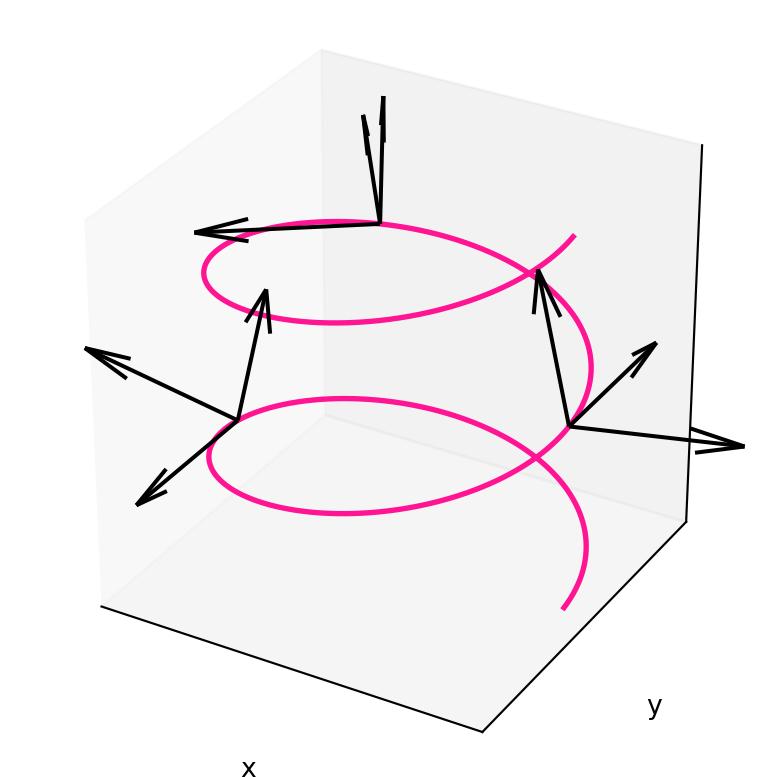
2 Curvature and Torsion
We have seen how to describe curves and reparametrized them. Now we want to look at local properties of curves:
- How much does a curve twist?
- How much does a curve bend?
We will measure two quantities:
- Curvature: measures how much a curve \({\pmb{\gamma}}\) deviates from a straight line.
- Torsion: measures how much a curve \({\pmb{\gamma}}\) deviates from a plane.
For example a 2D spiral is curved, but still lies in a plane. Instead the Helix both deviates from a straight line and pulls away from any fixed plane.
2.1 Curvature
We start with an informal discussion. Suppose \({\pmb{\gamma}}\) is a straight line \[ {\pmb{\gamma}}(t) = \mathbf{a} + t \mathbf{v} \] with \(\mathbf{a}, \mathbf{v} \in \mathbb{R}^3\). Whichever the definition of curvature will be, we expect the curvature of a straight line to be zero. The tangent vector to \({\pmb{\gamma}}\) is constant \[ \dot{{\pmb{\gamma}}}(t) = \mathbf{v} \,. \] If we further derive the tangent vector, we obtain \[ \ddot{{\pmb{\gamma}}}(t) = {\pmb{0}}\,. \] Thus \(\ddot{{\pmb{\gamma}}}\) seems to be a good candidate for the definition of curvature of \({\pmb{\gamma}}\) at the point \({\pmb{\gamma}}(t)\).
Suppose now that \({\pmb{\gamma}}\colon (a,b) \to \mathbb{R}^2\) is a planar curve with unit-speed. We have proven that in this case \[ \dot{{\pmb{\gamma}}}\cdot \ddot{{\pmb{\gamma}}}= 0 \,, \] that is, the vector \(\ddot{{\pmb{\gamma}}}\) is orthogonal to the tangent \(\dot{{\pmb{\gamma}}}\) at all times. Now let \(\mathbf{n}(t)\) be the unit vector orthogonal to \(\dot{{\pmb{\gamma}}}(t)\) at the point \({\pmb{\gamma}}(t)\). The amount that the curve \({\pmb{\gamma}}\) deviates from its tangent at \({\pmb{\gamma}}(t)\) after time \(t_0\) is \[ [ {\pmb{\gamma}}(t + t_0) - {\pmb{\gamma}}(t) ] \cdot \mathbf{n}(t) \,, \tag{2.1}\] as seen in Figure Figure 2.1.
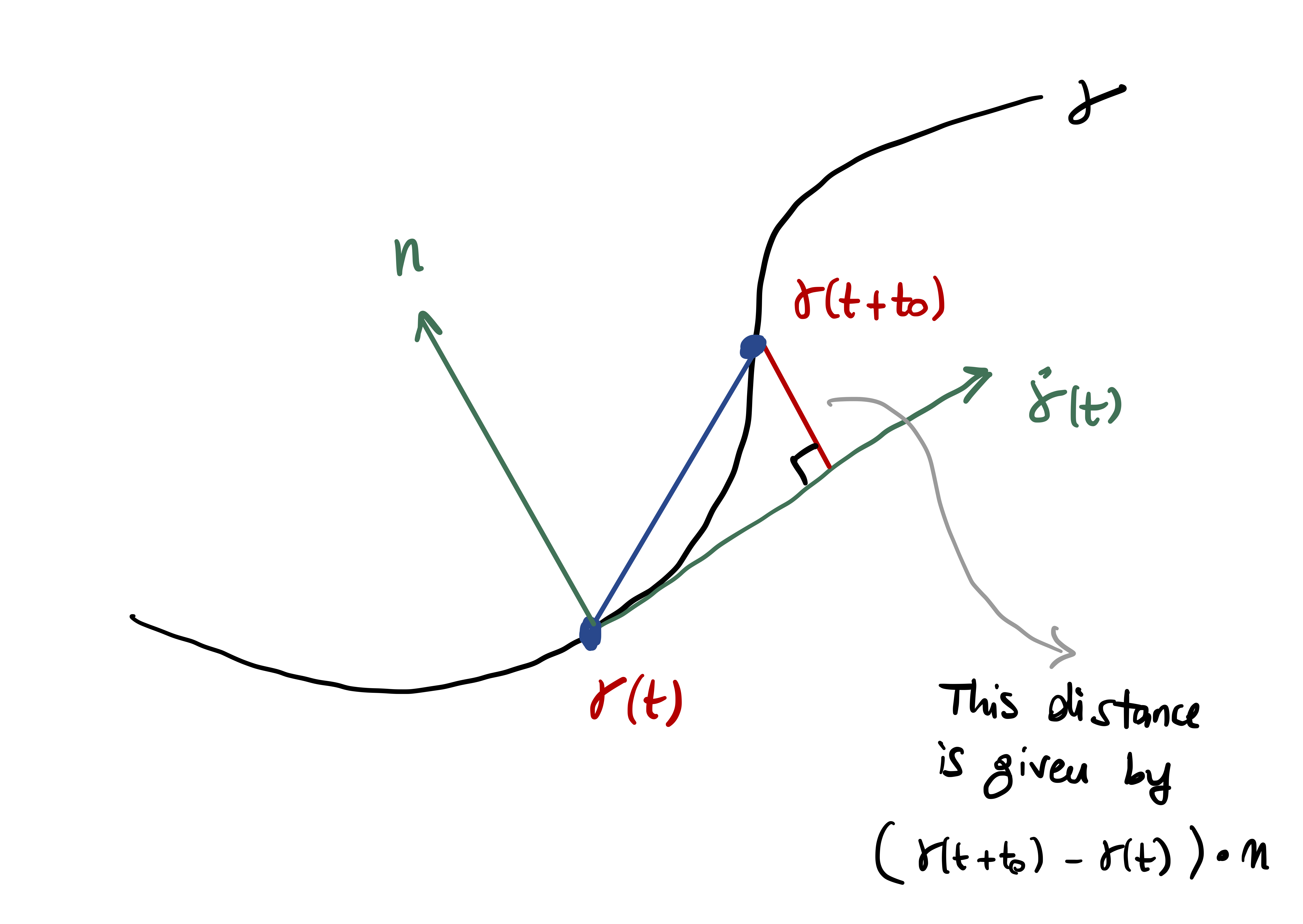
Equation (2.1) is what we take as measure of curvature. Since \[ \dot{{\pmb{\gamma}}}(t) \cdot \ddot{{\pmb{\gamma}}}(t) = 0 \quad \mbox{ and } \quad \dot{{\pmb{\gamma}}}(t) \cdot \mathbf{n}(t)= 0 \,, \] we conclude that \(\ddot{{\pmb{\gamma}}}(s)\) is parallel to \(\mathbf{n}(t)\). Since \(\mathbf{n}(t)\) is a unit vector, there exists a scalar \(\kappa(t)\) such that \[ \ddot{{\pmb{\gamma}}}(t) = \kappa(t) \, \mathbf{n}(t) \,. \] Taking the norms of the above and recalling that \(\left\| \mathbf{n} \right\| = 1\) gives \[ \kappa(t) = \left\| \ddot{{\pmb{\gamma}}}(t) \right\| \] Now, approximate \({\pmb{\gamma}}\) at \(t\) with its second order Taylor polynomial: \[ {\pmb{\gamma}}(t+t_0) = {\pmb{\gamma}}(t) + \dot{{\pmb{\gamma}}}(t) t_0 + \frac{\ddot{{\pmb{\gamma}}}(t)}{2} t_0^2 + o(t_0^2) \] where the remainder \(o(t_0^2)\) is such that \[ \lim_{t_0 \to 0} \ \frac{o(t_0^2)}{t_0^2} = 0 \,. \] Therefore, discarding the remainder, \[ {\pmb{\gamma}}(t+t_0) - {\pmb{\gamma}}(t) \approx \dot{{\pmb{\gamma}}}(t) t_0 + \frac{\ddot{{\pmb{\gamma}}}(t)}{2} t_0^2 \,. \] Multiplying by \(\mathbf{n}(t)\) we get \[ ({\pmb{\gamma}}(t+t_0) - {\pmb{\gamma}}(t)) \cdot \mathbf{n}(t) \approx \dot{{\pmb{\gamma}}}(t) \cdot \mathbf{n}(t) t_0 + \frac{\ddot{{\pmb{\gamma}}}(t) \cdot \mathbf{n}(t) }{2} t_0^2\,. \] Recalling that \[ \dot{{\pmb{\gamma}}}(t) \cdot \mathbf{n}(t) = 0\,, \quad \ddot{{\pmb{\gamma}}}(t) \cdot \mathbf{n}(t) = \kappa(t) \,, \] we then obtain \[ [{\pmb{\gamma}}(t + t_0) - {\pmb{\gamma}}(t) ] \cdot \mathbf{n}(t) \approx \frac{1}{2} \, \kappa(t) \, t_0^2 \]
Important
We take this as definition of curvature for a general unit-speed curve in \(\mathbb{R}^n\).
Definition 1: Curvature of unit-speed curve
Note that \(\kappa(t)\) is a function of the parameter \(t\): The curvature of \({\pmb{\gamma}}\) can change from point to point.
Example 2: Curvature of the Circle
Solution. First, check that \({\pmb{\gamma}}\) is unit-speed: \[ \dot{{\pmb{\gamma}}}(t) = \left( - \sin \left( \frac{t}{R} \right) , \cos \left( \frac{t}{R} \right), 0\right) \,, \qquad \left\| \dot{{\pmb{\gamma}}}(t) \right\| = 1 \, \] Now, compute second derivative and curvature \[\begin{align*} \ddot{{\pmb{\gamma}}}(t) & = \left( -\frac{1}{R} \cos \left( \frac{t}{R} \right) , - \frac{1}{R} \sin \left( \frac{t}{R} \right) ,0\right) \,, \\ \kappa(t) & = \left\| \ddot{{\pmb{\gamma}}}(t) \right\| = \frac{1}{R} \,. \end{align*}\]
Question: How do we define curvature for arbitrary curves?
Answer: When \({\pmb{\gamma}}\) is regular we can use unit-speed reparametrizations to define \(\kappa\).
Definition 3: Curvature of regular curve
In order for the above definition to make sense, we need to check that the curvature \(\kappa\) does not change if we choose a different unit-speed reparametrization. This is shown in the next Proposition.
Proposition 4: \(\kappa\) is invariant for unit-speed reparametrization
Proof
Remark 5: Computing curvature of regular \({\pmb{\gamma}}\)
Compute the arc-length \(s(t)\) of \({\pmb{\gamma}}\) and its inverse \(t(s)\).
Compute the arc-length reparametrization \[ \widetilde{{\pmb{\gamma}}}(s) = {\pmb{\gamma}}(t(s)) \,. \]
Compute the curvature of \(\widetilde{{\pmb{\gamma}}}\) \[ \widetilde{\kappa}(s) = \left\| \ddot{\widetilde{{\pmb{\gamma}}}}(s) \right\|\,. \]
The curvature of \({\pmb{\gamma}}\) is \[ \kappa (t)= \widetilde{\kappa}(s(t)) \,. \]
Important
Before proceeding with the next example, let us give a short overview of the Hyperbolic functions.
Definition 6: Hyperbolic functions
The hyperbolic functions are defined by:
Hyperbolic cosine: The even part of the function \(e^t\), that is, \[ \cosh (t) = \frac {e^t + e^{-t}} {2} = \frac {e^{2t} + 1} {2e^t} = \frac {1 + e^{-2t}} {2e^{-t}} \,. \]
Hyperbolic sine: The odd part of the function \(e^t\), that is, \[ \sinh (t) = \frac {e^t - e^{-t}} {2} = \frac {e^{2t} - 1} {2e^t} = \frac {1 - e^{-2t}} {2e^{-t}} \,. \]
Hyperbolic tangent: \[ \tanh(t) = \frac{\sinh (t)}{\cosh (t)} = \frac {e^t - e^{-t}} {e^t + e^{-t}} = \frac{e^{2t} - 1} {e^{2t} + 1} \,. \]
Hyperbolic cotangent: The reciprocal of \(\tanh\) for \(t \neq 0\), \[ \coth (t) = \frac{\cosh (t)}{\sinh (t)} = \frac {e^t + e^{-t}} {e^t - e^{-t}} = \frac{e^{2t} + 1} {e^{2t} - 1} \,. \]
Hyperbolic secant: The reciprocal of \(\cosh\) \[ \mathop{\mathrm{sech}}(t) = \frac{1}{\cosh (t)} = \frac {2} {e^t + e^{-t}} = \frac{2e^t} {e^{2t} + 1} \,. \]
Hyperbolic cosecant: The reciprocal of \(\sinh\) for \(t \neq 0\), \[ \mathop{\mathrm{csch}}(t) = \frac{1}{\sinh (t)} = \frac {2} {e^t - e^{-t}} = \frac{2e^t} {e^{2t} - 1} \,. \]
For a plot \(\cosh, \sinh, \tanh\), see Figure 2.2 below.
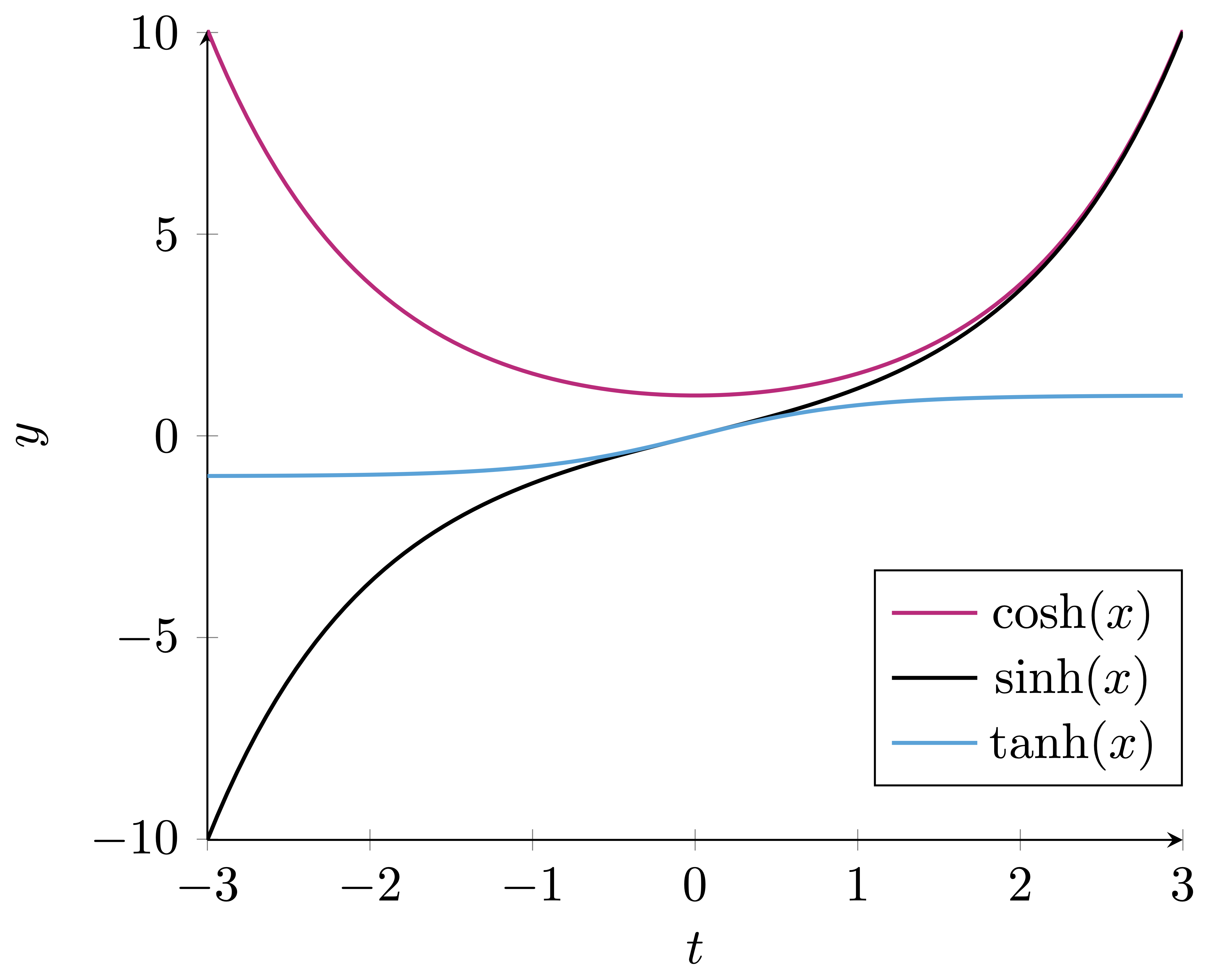
Theorem 7: Properties of Hyperbolic Functions
Derivatives: \[\begin{align*} & \sinh(t)' = \cosh (t) &\,\,\,& \cosh(t)' = \sinh (t) \\ & \tanh(t)' = {\mathop{\mathrm{sech}}}^2(t) &\,\,\,& \mathop{\mathrm{sech}}(t)' = - {\mathop{\mathrm{sech}}}(t) \tanh(t) \end{align*}\]
Integrals: \[\begin{align*} \int_{t_0}^t \sinh(u) \, du & = \cosh (t) - \cosh( t_0 ) \\ \int_{t_0}^t \cosh(u) \, du & = \sinh (t) - \sinh( t_0 ) \\ \int_{t_0}^t \tanh(u) \, du & = \log ( \cosh (t) ) - \log ( \cosh (t_0) ) \end{align*}\]
Definition 8
Example 9: Curvature of the Catenary
Question. Consider the Catenary curve \[ {\pmb{\gamma}}(t) = ( t, \cosh(t) ) \,, \quad t \in \mathbb{R}\,. \]
- Prove that \({\pmb{\gamma}}\) is regular.
- Compute the arc-length reparametrization of \({\pmb{\gamma}}\).
- Compute the curvature of \(\widetilde{{\pmb{\gamma}}}\).
- Compute the curvature of \({\pmb{\gamma}}\).
Solution.
\({\pmb{\gamma}}\) is regular because \[\begin{align*} \dot{{\pmb{\gamma}}}(t) & = (1 , \sinh(t)) \\ \left\| \dot{{\pmb{\gamma}}} \right\| & = \sqrt{1 + {\sinh}^2 (t)} = \cosh (t) \geq 1 \end{align*}\]
The arc-length of \({\pmb{\gamma}}\) starting at \(t_0 = 0\) is \[ s(t) = \int_0^t \left\| \dot{{\pmb{\gamma}}}(u) \right\| \, du = \int_0^t \cosh (u) \, du = \sinh (t) \] where we used that \(\sinh(0) = 0\). Moreover, \[\begin{align*} s = \sinh(t) \quad & \iff \quad s = \frac{e^t - e^{-t}}{2} \\ \quad & \iff \quad e^{2t} - 2s e^{t} - 1 = 0 \end{align*}\] Substitute \(y = e^t\) to obtain \[\begin{align*} e^{2t} - 2s e^{t} - 1 = 0 \quad & \iff \quad y^{2} - 2s y - 1 = 0 \\ \quad & \iff \quad y_{\pm} = s \pm \sqrt{1+s^2} \,. \end{align*}\] Notice that \[ y_{+} = s + \sqrt{1 + s^2} \geq s + \sqrt{s^2} = s + |s| \geq 0 \] by definition of absolute value. Therefore, \[\begin{align*} e^t = y_+ = s + \sqrt{1 + s^2 } \,\, \implies \,\, t(s) = \log \left( s + \sqrt{1 + s^2} \right) \end{align*}\] The arc-length reparametrization of \({\pmb{\gamma}}\) is \[ \widetilde{{\pmb{\gamma}}}(s) = {\pmb{\gamma}}( t(s) ) = \left( \log \left( s + \sqrt{ 1+ s^2} \right) , \sqrt{1 + s^2} \right) \]
Compute the curvature of \(\widetilde{{\pmb{\gamma}}}\) \[\begin{align*} \dot{\widetilde{{\pmb{\gamma}}}}(s) & = \left( \frac{1}{ \sqrt{1 + s^2} } , \frac{s}{ \sqrt{1 + s^2}} \right) \\ \ddot{\widetilde{{\pmb{\gamma}}}}(s) & = \left( - \frac{s}{ (1 + s^2)^{3/2} } , \frac{1}{(1 + s^2)^{3/2} } \right) \\ \widetilde{\kappa}(s) & = \left\| \ddot{\widetilde{{\pmb{\gamma}}}}(s) \right\|= \frac{1}{1+s^2} \end{align*}\]
Recalling that \(s(t) = \sinh(t)\), the curvature of \({\pmb{\gamma}}\) is \[ \kappa (t) = \widetilde{\kappa}(s(t)) = \frac{1}{1+ \sinh^2(t)} = \frac{1}{\cosh^2(t)} \,. \]
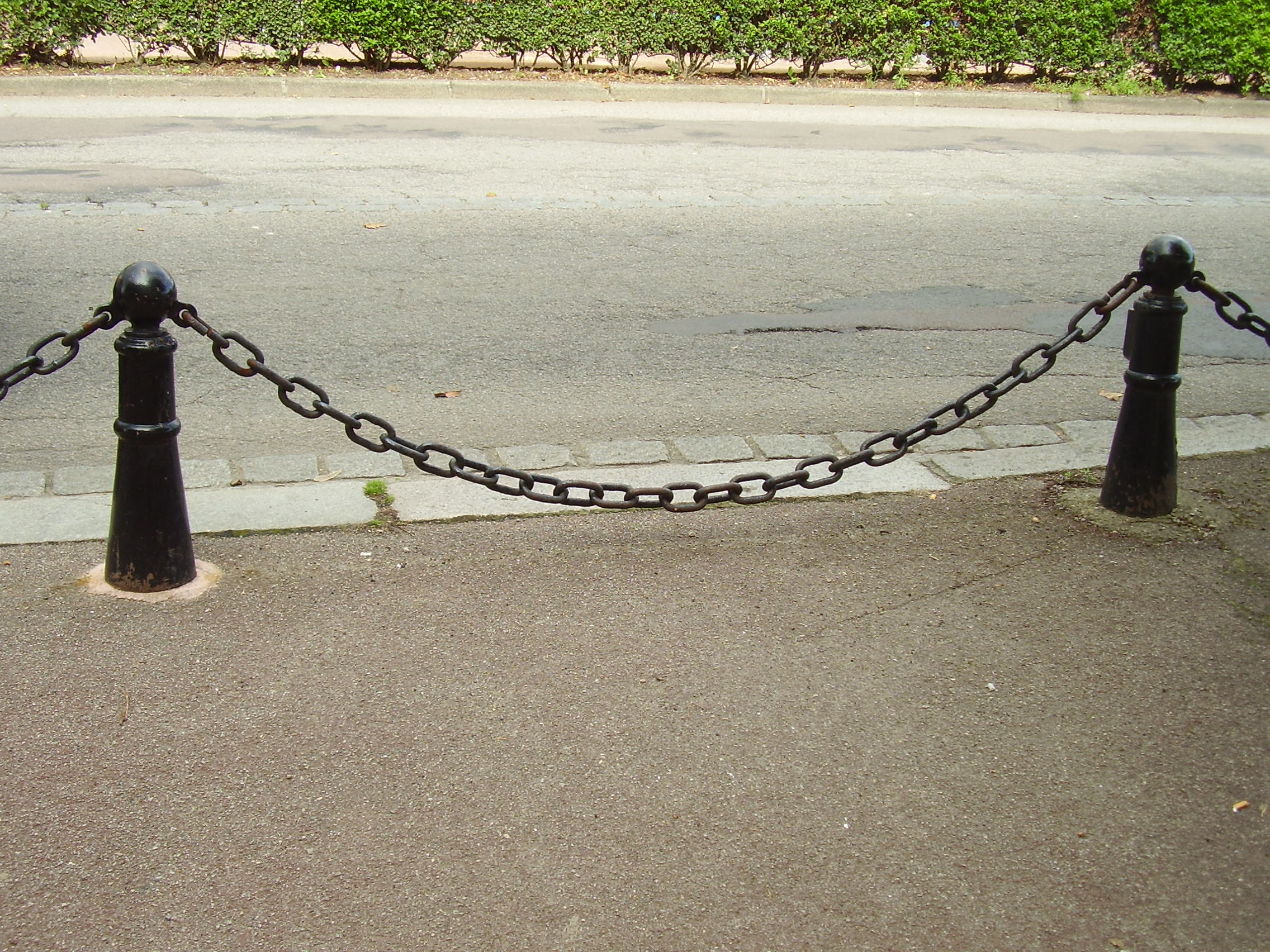
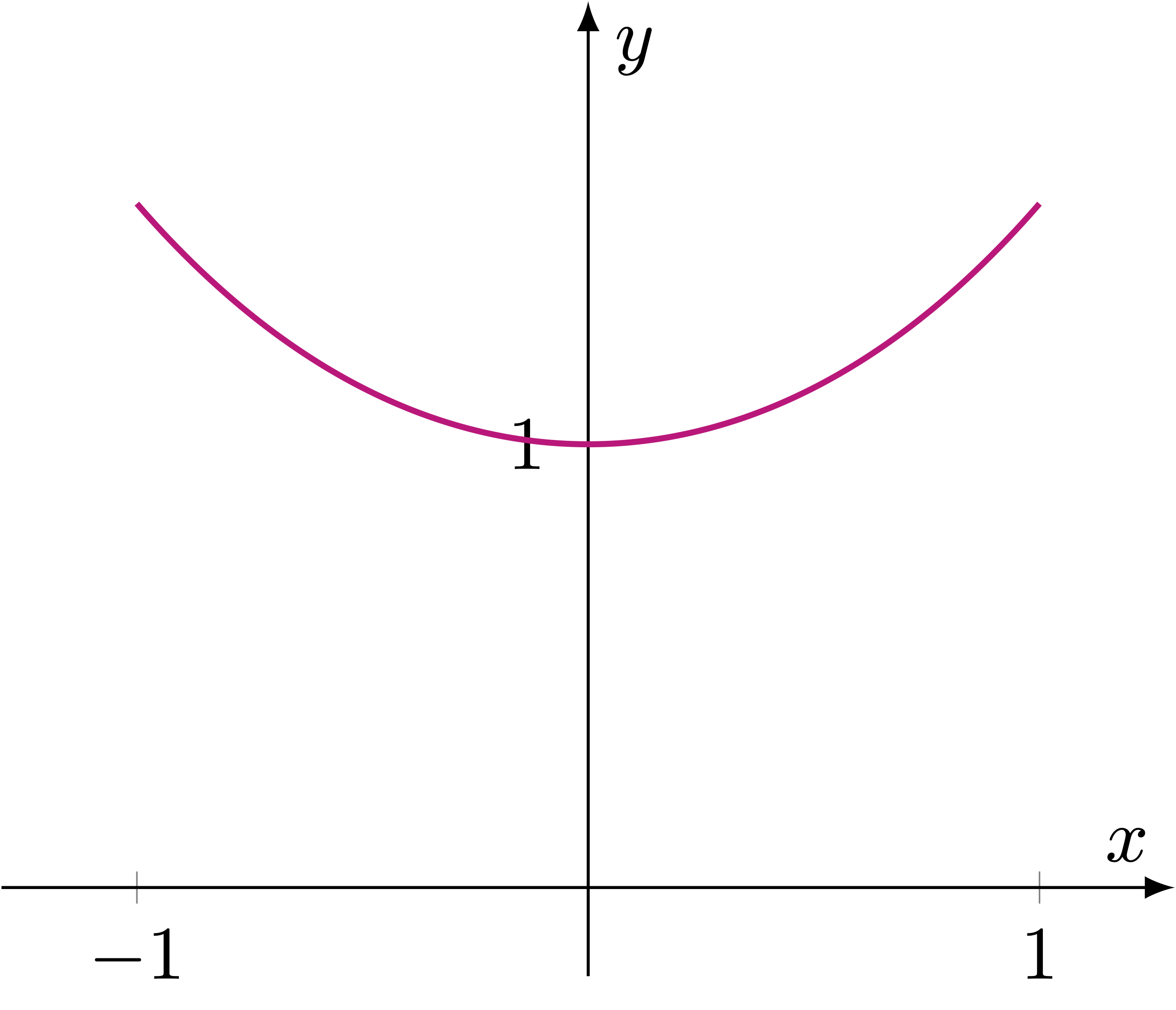
2.2 Vector product in \(\mathbb{R}^3\)
The discussion in this section follows (do Carmo 2017). We start by defining orientation for a vector space.
Definition 10: Same orientation
When two basis \(B\) and \(\widetilde{B}\) have the same orientation, we write \[ B \sim \widetilde{B} \,. \] The above is clearly an equivalence relation on the set of ordered basis. Therefore the set of ordered basis of \(\mathbb{R}^3\) can be decomposed into equivalence classes. Since the determinant of the matrix of change of basis can only be positive or negative, there are only two equivalence classes.
Definition 11: Orientation
Definition 12: Positive orientation
Consider the standard basis of \(\mathbb{R}^3\) \[ E = (\mathbf{e}_1,\mathbf{e}_2,\mathbf{e}_3) \] where we set \[ \mathbf{e}_1 = (1,0,0)\,, \quad \mathbf{e}_2 = (0,1,0) \,, \quad \mathbf{e}_3 = (0,0,1) \,. \] Then:
- The orientation corresponding to \(E\) is called positive orientation of \(\mathbb{R}^3\).
- The orientation corresponding to the other equivalence class is called negative orientation of \(\mathbb{R}^3\).
For a basis \(B\) of \(\mathbb{R}^3\) we say that:
- \(B\) is a positive basis if it belongs to the class of \(E\).
- \(B\) is a negative basis if it does not belong to the class of \(E\).
Example 13
Consider instead \[ \widetilde{E} = (\mathbf{e}_2,\mathbf{e}_1,\mathbf{e}_3) \,. \] The matrix of change of variables between \(\widetilde{E}\) and \(E\) is \[ P = (\mathbf{e}_2 | \mathbf{e}_1 | \mathbf{e}_3 ) = \left( \begin{array}{ccc} 0 & 1 & 0 \\ 1 & 0 & 0 \\ 0 & 0 & 1 \\ \end{array} \right) \] and clearly \[ \det P = - 1 < 0 \,. \] Thus \(\widetilde{E}\) does not belong to the class of \(E\), and is therefore a negative basis.
We are now ready to define the vector product in \(\mathbb{R}^3\).
Definition 14: Vector product in \(\mathbb{R}^3\)
The following proposition gives an explicit formula for computing \(\mathbf{u}\times \mathbf{v}\).
Proposition 15
Proof
Notation
Let us collect some crucial properties of the vector product.
Proposition 16
The vector product in \(\mathbb{R}^3\) satisfies the following properties: For all \(\mathbf{u}, \mathbf{v}\in \mathbb{R}^3\)
\(\mathbf{u}\times \mathbf{v}= - \mathbf{v}\times \mathbf{u}\)
\(\mathbf{u}\times \mathbf{v}= {\pmb{0}}\) if and only if \(\mathbf{u}\) and \(\mathbf{v}\) are linearly dependent
\((\mathbf{u}\times \mathbf{v}) \cdot \mathbf{u}= 0\), \((\mathbf{u}\times \mathbf{v}) \cdot \mathbf{v}= 0\)
For all \(\mathbf{w}\in \mathbb{R}^3\), \(a,b \in \mathbb{R}\) \[ (a\mathbf{u}+ b\mathbf{w}) \times \mathbf{v}= a \mathbf{u}\times \mathbf{v}+ b\mathbf{w}\times \mathbf{w} \]
For all \(\mathbf{x},\mathbf{y}\in \mathbb{R}^3\) it holds \[ (\mathbf{u}\times \mathbf{v}) \cdot (\mathbf{x}\times \mathbf{y}) = \left| \begin{array}{cc} \mathbf{u}\cdot \mathbf{x}& \mathbf{v}\cdot \mathbf{x}\\ \mathbf{u}\cdot \mathbf{y}& \mathbf{v}\cdot \mathbf{y} \end{array} \right| \tag{2.6}\]
Denote by \(\theta\) the angle between \(\mathbf{v}\) and \(\mathbf{w}\) \[ \theta := \cos^{-1} \left ( \frac{\mathbf{u}\cdot \mathbf{w}}{ \| \mathbf{v}\| \|\mathbf{w}\| } \right) \,. \] The following identity holds \[ \| \mathbf{u}\times \mathbf{v}\| = \| \mathbf{u}\|^2 \| \mathbf{v}\|^2 \sin^2(\theta) \tag{2.7}\]
Proof
For point (1) we have \[\begin{align*} (\mathbf{u}\times \mathbf{v}) \cdot \mathbf{w}& = \left| \begin{array}{ccc} u_1 & u_2 & u_2 \\ v_1 & v_2 & v_3 \\ w_1 & w_2 & w_3 \end{array} \right| \\ & = - \left| \begin{array}{ccc} v_1 & v_2 & v_3 \\ u_1 & u_2 & u_2 \\ w_1 & w_2 & w_3 \end{array} \right| \\ & = - (\mathbf{v}\times \mathbf{u}) \cdot \mathbf{w} \end{align*}\] where we used that swapping two rows in a matrix changes the sign of the determinant. Since \(\mathbf{w}\) is arbitrary, we conclude point (1).
Let \(A \in \mathbb{R}^{3 \times 3}\) be a matrix. Points (2)-(3) follow from the fact that \[ \det(A) = 0 \] if and only if at least 2 rows or columns of \(A\) are linearly dependent.
Point (4) can be easily verified by direct calculation.
Point (5) can be obtained as follows: Check by hand that formula (2.6) holds for the vectors of the standard basis \(\mathbf{e}_1, \mathbf{e}_2,\mathbf{e}_3\); Then write the vectors \(\mathbf{v}, \mathbf{w}, \mathbf{x},\mathbf{y}\) in coordinates with
respect to the standard basis; Using the linearity of the vector product obtained in point (4), conclude that (2.6) holds for \(\mathbf{v}, \mathbf{w}, \mathbf{x},\mathbf{y}\).By definition of \(\theta\) we have \[ \mathbf{v}\cdot \mathbf{w}= \| \mathbf{v}\| \|\mathbf{w}\| \cos(\theta) \] Applying (2.6) with \(\mathbf{x}= \mathbf{v}\) and \(\mathbf{y}= \mathbf{w}\) we conclude \[\begin{align*} \| \mathbf{u}\times \mathbf{v}\|^2 & = (\mathbf{u}\times \mathbf{v}) \cdot (\mathbf{u}\times \mathbf{v}) = \left| \begin{array}{cc} \mathbf{u}\cdot \mathbf{u}& \mathbf{v}\cdot \mathbf{u}\\ \mathbf{u}\cdot \mathbf{v}& \mathbf{v}\cdot \mathbf{v} \end{array} \right| \\ & = \| \mathbf{u}\|^2 \| \mathbf{v}\|^2 - |\mathbf{u}\cdot \mathbf{v}|^2 \\ & = \| \mathbf{u}\|^2 \| \mathbf{v}\|^2 - \| \mathbf{u}\|^2 \| \mathbf{v}\|^2 \cos^2(\theta) \\ & = \| \mathbf{u}\|^2 \| \mathbf{v}\|^2 (1-\cos^2(\theta)) \\ & = \| \mathbf{u}\|^2 \| \mathbf{v}\|^2 \sin^2(\theta) \end{align*}\]
Remark 17: Geometric interpretation of vector product
Let \(\mathbf{u}, \mathbf{v}\in \mathbb{R}^3\) be linearly independent. We make some observations:
Property 3 in Proposition 16 says that \[ (\mathbf{u}\times \mathbf{v}) \cdot \mathbf{u}= 0 \,, \quad (\mathbf{u}\times \mathbf{v}) \cdot \mathbf{v}= 0 \,. \] Therefore \(\mathbf{u}\times \mathbf{v}\) is orthogonal to both \(\mathbf{u}\) and \(\mathbf{v}\).
In particular \(\mathbf{u}\times \mathbf{v}\) is orthogonal to the plane generated by \(\mathbf{u}\) and \(\mathbf{v}\).
Since \(\mathbf{u}\) and \(\mathbf{v}\) are linearly independent, Property 2 in Proposition 16 says that \[ \mathbf{u}\times \mathbf{v}\neq {\pmb{0}} \]
Therefore we have \[ (\mathbf{u}\times \mathbf{v}) \cdot (\mathbf{u}\times \mathbf{v}) = \left\| \mathbf{u}\times \mathbf{v} \right\|^2 > 0 \]
On the other hand, using the definition of \(\mathbf{u}\times \mathbf{v}\) with \(\mathbf{w}= \mathbf{v}\times \mathbf{w}\) yields \[ (\mathbf{u}\times \mathbf{v}) \cdot (\mathbf{u}\times \mathbf{v}) = \left| \begin{array}{ccc} u_1 & u_2 & u_3 \\ v_1 & v_2 & v_3 \\ (\mathbf{u}\times \mathbf{v})_1 & (\mathbf{u}\times \mathbf{v})_2 & (\mathbf{u}\times \mathbf{v})_3 \\ \end{array} \right| \]
Therefore the determinant of the matrix \[ (\mathbf{u}| \mathbf{v}| \mathbf{u}\times \mathbf{v}) \] is positive. This shows that \[ (\mathbf{u}, \mathbf{v}, \mathbf{u}\times \mathbf{v}) \] is a positive basis of \(\mathbb{R}^3\).
Let \(\theta\) be the angle between \(\mathbf{v}\) and \(\mathbf{w}\) and \(A\) the area of the parallelogram with sides \(\mathbf{u}\) and \(\mathbf{v}\), see Figure 2.5. Basic trigonometry gives that \[ A = \| u \| \| v \| \sin (\theta) \,. \] Using (2.6) we have \[ \| \mathbf{u}\times \mathbf{v}\| = \| \mathbf{u}\| \| \mathbf{v}\| \sin(\theta) = A \]
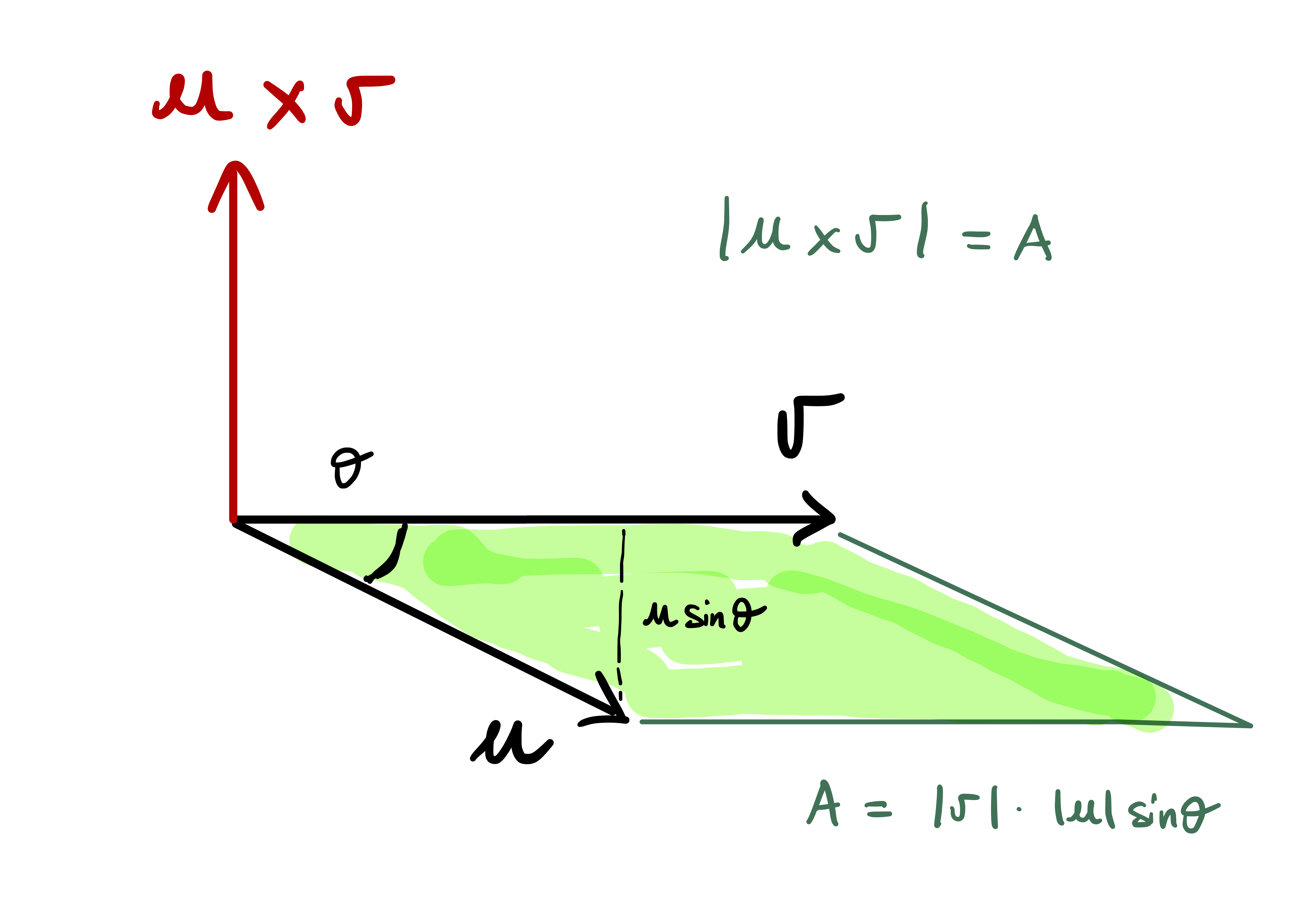
We have therefore proven the following theorem.
Theorem 18: Geometric Properties of vector product
Let \(\mathbf{u},\mathbf{v}\in \mathbb{R}^3\) be linearly independent. Then
- \(\mathbf{u}\times \mathbf{v}\) is orthogonal to the plane spanned by \(\mathbf{u},\mathbf{v}\)
- \(\| \mathbf{u}\times \mathbf{v}\|\) is the area of the parallelogram with sides \(\mathbf{u},\mathbf{v}\)
- The triple \((\mathbf{u},\mathbf{v},\mathbf{u}\times \mathbf{v})\) is a positive basis of \(\mathbb{R}^3\)
We conclude with noting that the cross product is not associative, and with a useful proposition for differentiating the cross product of curves in \(\mathbb{R}^3\).
Theorem 19
Theorem 20
The proof is omitted. It follows immediately from formula (2.5).
2.3 Curvature formula in \(\mathbb{R}^3\)
Given a unit-speed curve \[ {\pmb{\gamma}}\ \colon (a,b) \to \mathbb{R}^n \] we defined its curvature as \[ \kappa(t) := \left\| \ddot{{\pmb{\gamma}}}(t) \right\| \,. \] When \({\pmb{\gamma}}\) is regular we defined the curvature as \[ \kappa(t) := \widetilde{\kappa}(s(t)) \] where \[ \widetilde{\kappa}(s) := \left\| \ddot{\widetilde{{\pmb{\gamma}}}}(s) \right\| \] is the curvature of the arc-length reparametrization \(\widetilde{{\pmb{\gamma}}}:= {\pmb{\gamma}}\circ s^{-1}\) of \({\pmb{\gamma}}\).
If \({\pmb{\gamma}}\) is a regular curve in \(\mathbb{R}^3\) the following formula can be used to compute \(\kappa\) without passing through \(\widetilde{{\pmb{\gamma}}}\).
Theorem 21: Curvature formula
We delay the proof of the above Proposition, as this will get easier when the Frenet-Serret equations are introduced. For a proof which does not make use of the Frenet-Serret equations see Proposition 2.1.2 in (Pressley 2010).
For now we use (2.10) to compute the curvature of specific curves.
Example 22: Curvature of the Straight Line
Question. Consider the straight line \[ {\pmb{\gamma}}(t) = \mathbf{a} + t \mathbf{v} \,, \] for some \(\mathbf{a}, \mathbf{v} \in \mathbb{R}^3\) fixed, with \(\mathbf{v} \neq {\pmb{0}}\).
- Prove that \({\pmb{\gamma}}\) is regular.
- Compute the curvature of \({\pmb{\gamma}}\).
Solution.
\({\pmb{\gamma}}\) is regular because \[ \dot{{\pmb{\gamma}}}(t) = \mathbf{v} \neq {\pmb{0}}\,. \]
We have \(\left\| \dot{{\pmb{\gamma}}} \right\| = \|\mathbf{v}\|\) and \(\ddot{{\pmb{\gamma}}}= \mathbf{v}\). Thus, \[ \dot{{\pmb{\gamma}}}\times \ddot{{\pmb{\gamma}}}= \mathbf{v} \times {\pmb{0}}= {\pmb{0}}\,, \] and the curvature is \[ \kappa(t) = \frac{ \left\| \dot{{\pmb{\gamma}}}\times \ddot{{\pmb{\gamma}}} \right\| }{ \left\| \dot{{\pmb{\gamma}}} \right\|^3 } = 0 \,. \]
Example 23: Curvature of the Helix
Question. Consider the Helix of radius \(R>0\) and rise \(H\), \[ {\pmb{\gamma}}(t) = ( R\cos(t) , R\sin(t) , Ht) \,. \]
- Prove that \({\pmb{\gamma}}\) is regular.
- Compute the curvature of \({\pmb{\gamma}}\).
Solution.
\({\pmb{\gamma}}\) is regular because \[\begin{align*} \dot{{\pmb{\gamma}}}(t) & = ( -R\sin(t) , R\cos(t) , H) \\ \left\| \dot{{\pmb{\gamma}}}(t) \right\| & = \sqrt{R^2 + H^2} \geq R > 0 \end{align*}\]
Compute the curvature using the formula: \[\begin{align*} \ddot{{\pmb{\gamma}}}(t) & = ( -R\cos(t) , -R\sin(t) , 0) \\ \dot{{\pmb{\gamma}}}\times \ddot{{\pmb{\gamma}}}& = \left( RH\sin(t), -RH\cos(t), R^2 \right) \\ \left\| \dot{{\pmb{\gamma}}}\times \ddot{{\pmb{\gamma}}} \right\| & = R\sqrt{R^2 + H^2 } \\ \kappa (t) & = \frac{ \left\| \dot{{\pmb{\gamma}}}(t) \times \ddot{{\pmb{\gamma}}}(t) \right\| }{ \left\| \dot{{\pmb{\gamma}}}(t) \right\|^3 } = \frac{ R }{ R^2 + H^2 } \end{align*}\]
Remark 24
We notice the following:
If \(H=0\) then the Helix is just a circle of radius \(R\). In this case the curvature is \[ \kappa = \frac{1}{R} \] which agrees with the curvature computed for the circle of radius \(R\).
If \(R=0\) then the Helix is just parametrizing the \(z\)-axis. In this case the curvature is \[ \kappa = 0 \,, \] which agrees with the curvature of a straight line.
Example 25: Calculation of curvature
Question. Define the curve \[ {\pmb{\gamma}}(t)=\left(\frac{8}{5} \cos (t), 1-2 \sin (t), \frac{6}{5} \cos (t)\right) \,. \]
- Prove that \({\pmb{\gamma}}\) is regular.
- Compute the curvature of \({\pmb{\gamma}}\).
Solution.
\({\pmb{\gamma}}\) is regular because \[ \dot{{\pmb{\gamma}}}=\left(-\frac{8}{5} \sin (t),-2 \cos (t),-\frac{6}{5} \sin (t)\right) \,, \qquad \|\dot{{\pmb{\gamma}}}\| =2 \neq 0 \,. \]
Compute the curvature using the formula: \[ \begin{aligned} & \ddot{{\pmb{\gamma}}}=\left(-\frac{8}{5} \cos (t), 2 \sin (t),-\frac{6}{5} \cos (t)\right) &\,\,\,\,& \|\dot{{\pmb{\gamma}}}\times \ddot{{\pmb{\gamma}}}\|=4 \\ & \dot{{\pmb{\gamma}}}\times \ddot{{\pmb{\gamma}}}=\left(-\frac{12}{5}, 0, \frac{16}{5}\right) &\,\,\,\,& \kappa = \frac{1}{2} \,. \end{aligned} \]
2.4 Signed curvature of plane curves
In this section we assume to have plane curves, that is, curves with values in \(\mathbb{R}^2\). In this case we can give a geometric interpretation for the sign of the curvature. This cannot be done in higher dimension.
Definition 26
Definition 27
Remark 28
Remark 29
- positive if \(\dot{{\pmb{\gamma}}}\) is rotating anti-clockwise
- negative if \(\dot{{\pmb{\gamma}}}\) is rotating clockwise
In other words,
- \(k_s > 0\) means the curve is turning left,
- \(k_s < 0\) means the curve is turning right.
A rigorous justification of the above statement is found in Proposition 2.2.3 in (Pressley 2010).
For curves which are not unit-speed, we define the signed curvature as the signed curvature of the unit-speed reparametrization.
Definition 30
The signed curvature completely determines plane curves, in the sense of the following theorem.
Theorem 31: Characterization of plane curves
Let \(\phi\ \colon \mathbb{R}\to \mathbb{R}\) be smooth. Then:
There exists a unit-speed curve \({\pmb{\gamma}}\ \colon \mathbb{R}\to \mathbb{R}^2\) such that its signed curvature \(\kappa_s\) satisfies \[ \kappa_s(t) = \phi(t) \,, \quad \forall \, t \in \mathbb{R}\,. \]
Suppose that \(\widetilde{{\pmb{\gamma}}}\ \colon \mathbb{R}\to \mathbb{R}^2\) is a unit-speed curve such that its signed curvature \(\widetilde{\kappa}_s\) satisfies \[ \widetilde{\kappa}_s(t) = \phi(t) \,, \quad \forall \, t \in \mathbb{R}\,. \] Then \[ \widetilde{{\pmb{\gamma}}}= {\pmb{\gamma}} \] up to rotations and translations.
We do not prove the above theorem. For a proof, see Theorem 2.2.6 in (Pressley 2010).
2.5 Space curves
We will now deal with space curves, that is, curves with values in \(\mathbb{R}^3\). There are several issues compared to the plane case:
A 3D counterpart of the signed curvature is not available, since there is no notion of turning left or turning right.
We have seen in the previous section that the signed curvature completely characterizes plane curves. In 3D however curvature is not enough to characterize curves: there exist \({\pmb{\gamma}}\) and \({\pmb{\eta}}\) space curves such that \[ \kappa^{{\pmb{\gamma}}} = \kappa^{{\pmb{\eta}}} \quad \text{ but } \quad {\pmb{\gamma}}\neq {\pmb{\eta}}\,, \] that is, \({\pmb{\gamma}}\) and \({\pmb{\eta}}\) have same curvature but are different curves.
Example 32: Different curves, same curvature
Solution. Curvatures of \({\pmb{\gamma}}\) and \({\pmb{\eta}}\) were already computed: \[ \kappa^{\pmb{\gamma}}= \frac{1}{2}\,, \quad \kappa^{\pmb{\eta}}= \frac{S}{S^2 + H^2} \,. \] Imposing that \(\kappa^{\pmb{\gamma}}= \kappa^{\pmb{\eta}}\), we get \[ \frac12 = \frac{S}{S^2 + H^2} \quad \implies \quad H^2 = 2S - S^2 \,. \] Choosing \(S=1\) and \(H=1\) yields \(\kappa^{\pmb{\gamma}}= \kappa^{\pmb{\eta}}\).
Therefore curvature is not enough for characterizing space curves, and we need a new quantity. As we did with curvature, we start by considering the simpler case of unit-speed curves. We will also need to assume that the curvature is never zero.
We start by introducing the principal normal, which is just the unit vector obtained by renormalizing \(\ddot{{\pmb{\gamma}}}\).
Definition 33: Principal normal vector
Remark 34
Proof
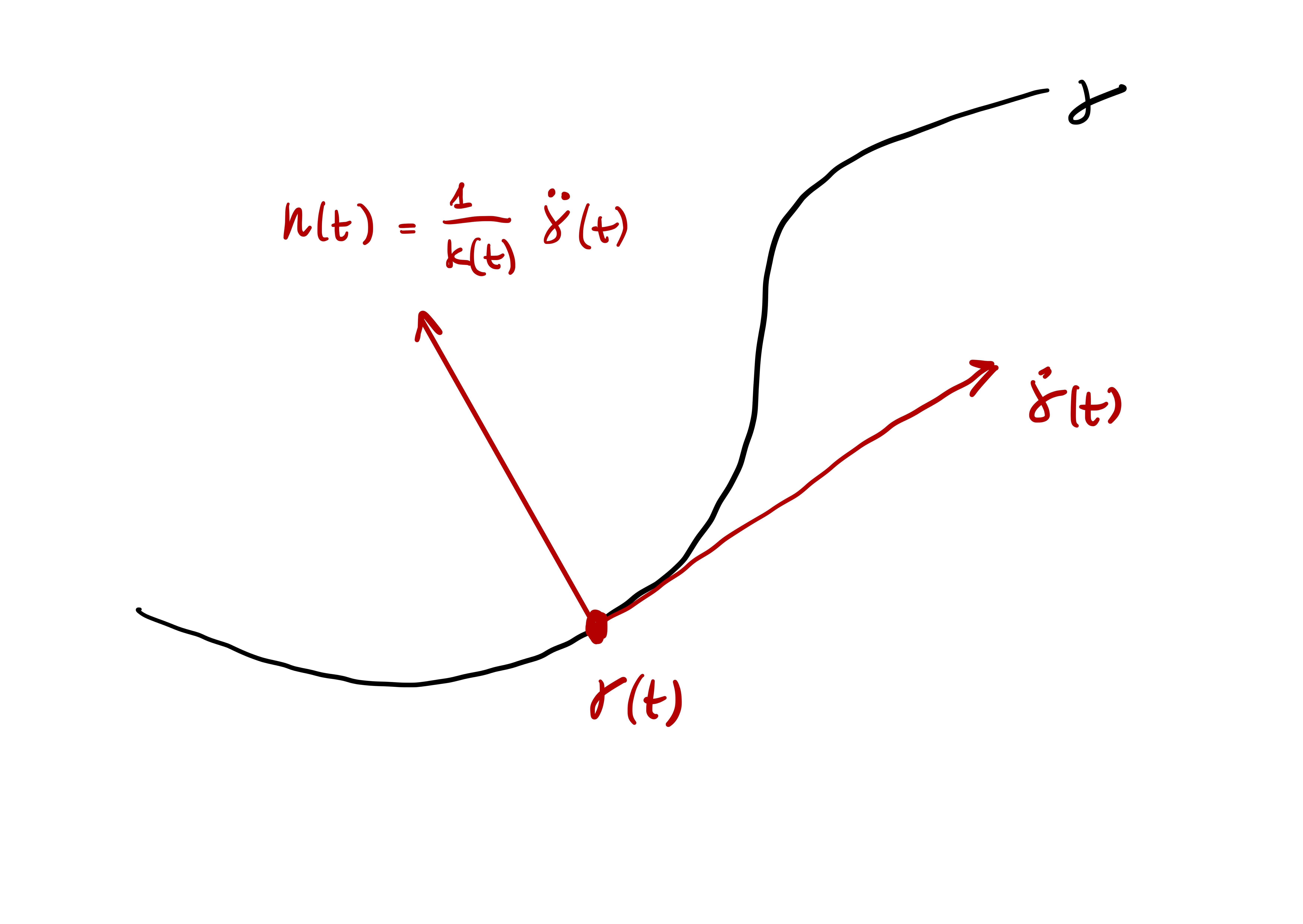
Question 35
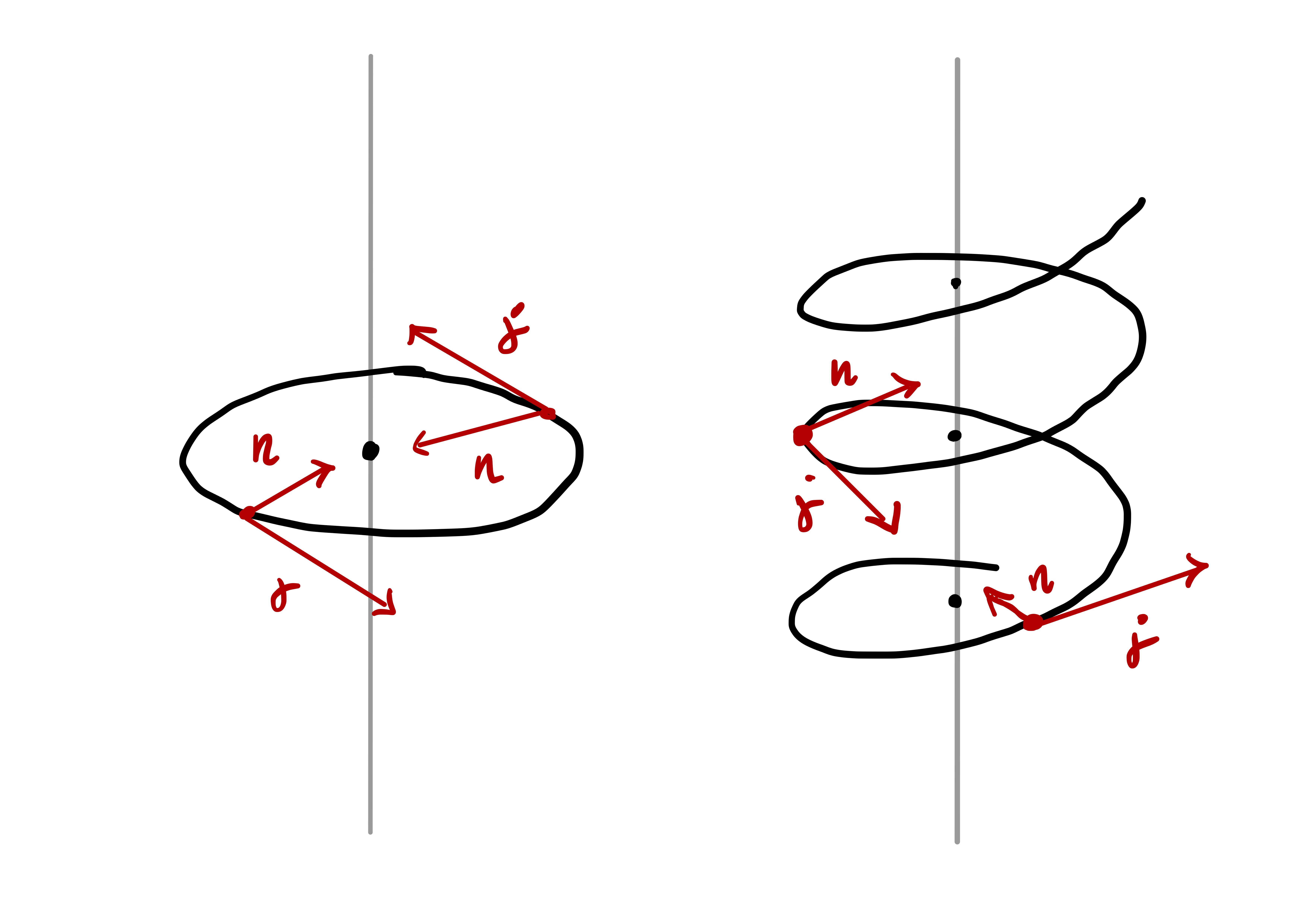
We now introduce the binormal vector \(\mathbf{b}\) as the vector product of \(\dot{{\pmb{\gamma}}}\) and \(\mathbf{n}\). By the properties of vector product we will see that the triple \[ (\dot{{\pmb{\gamma}}}, \mathbf{n}, \mathbf{b}) \] forms a positive orthonormal basis of \(\mathbb{R}^3\).
Definition 36: Binormal vector
To each unit-speed curve \({\pmb{\gamma}}\colon (a,b) \to \mathbb{R}^3\) with non-vanishing curvature, we can associate a triple of vectors, known as the Frenet frame.
Definition 37: Frenet frame
Notation
The Frenet frame is a positive orthonormal basis of \(\mathbb{R}^3\), in the following sense.
Definition 38: Orthonormal basis
Theorem 39: Frenet frame is orthonormal basis
Proof
By using unit-speed reparametrizations we can also compute the Frenet frame for regular curves with non-vanishing curvature. In doing so, we need to be aware of the following:
Warning
Definition 40
Let \({\pmb{\gamma}}\colon (a,b) \to \mathbb{R}^3\) be regular and \(\widetilde{{\pmb{\gamma}}}\) be a reparametrization with \[ {\pmb{\gamma}}= \widetilde{{\pmb{\gamma}}}\circ \phi \,, \quad \phi\colon (a,b) \to (\tilde{a},\tilde{b}) \,. \] We say that
- \(\widetilde{{\pmb{\gamma}}}\) is orientation preserving if \(\dot \phi> 0\)
- \(\widetilde{{\pmb{\gamma}}}\) is orientation reversing if \(\dot \phi< 0\)
Proposition 41: Frenet frame of reparametrization
Let \({\pmb{\gamma}}\) be unit-speed, with \(\kappa \neq 0\). Let \(\widetilde{{\pmb{\gamma}}}\) be a unit-speed reparametrization with \[ {\pmb{\gamma}}= \widetilde{{\pmb{\gamma}}}\circ \phi \,, \quad \phi\colon (a,b) \to (\tilde{a},\tilde{b}) \,. \] Then \(\dot{\phi}\) is constant, with either \[ \dot{\phi} \equiv 1 \quad \text{or} \quad \dot{\phi} \equiv - 1 \] Denote by \[ (\mathbf{t}, \mathbf{n}, \mathbf{b})\,, \qquad (\widetilde{\mathbf{t}}, \widetilde{\mathbf{n}}, \widetilde{\mathbf{b}}) \] the Frenet frames of \({\pmb{\gamma}}\) and \(\widetilde{{\pmb{\gamma}}}\), respectively. We have:
If \(\widetilde{{\pmb{\gamma}}}\) is orientation preserving then \(\dot \phi\equiv 1\) and \[ \mathbf{t}= \widetilde{\mathbf{t}}\circ \phi, \quad \mathbf{n}= \widetilde{\mathbf{n}}\circ \phi, \quad \mathbf{b}= \widetilde{\mathbf{b}}\circ \phi \]
If \(\widetilde{{\pmb{\gamma}}}\) is orientation reversing then \(\dot \phi\equiv -1\) and \[ \mathbf{t}= - \widetilde{\mathbf{t}}\circ \phi, \quad \mathbf{n}= \widetilde{\mathbf{n}}\circ \phi, \quad \mathbf{b}= -\widetilde{\mathbf{b}}\circ \phi \]
Proof
Differentiating \({\pmb{\gamma}}= \widetilde{{\pmb{\gamma}}}\circ \phi\) gives \[ \dot{{\pmb{\gamma}}}(t) = \dot{\widetilde{{\pmb{\gamma}}}}( \phi(t) ) \ \dot{\phi}(t) \tag{2.11}\] Taking the norms in (2.11) and recalling that \({\pmb{\gamma}}\) and \(\widetilde{{\pmb{\gamma}}}\) are unit speed yields \(|\dot{\phi} | = 1\). By continuity of \(\dot \phi\) either \[ \dot{\phi} \equiv 1 \quad \text{or} \quad \dot{\phi} \equiv - 1 \tag{2.12}\] Differentiating (2.11) one more time \[ \begin{aligned} \ddot{{\pmb{\gamma}}}(t) & = \ddot{\widetilde{{\pmb{\gamma}}}}( \phi(t) ) \ \dot{\phi}^2(t) + \dot{\widetilde{{\pmb{\gamma}}}}( \phi(t) ) \ \ddot{\phi}(t) \\ & = \ddot{\widetilde{{\pmb{\gamma}}}}( \phi(t) ) \end{aligned} \tag{2.13}\] where we used (2.12). By definition \[ \mathbf{t}:= \dot{{\pmb{\gamma}}}\,, \qquad \widetilde{\mathbf{t}}:= \dot{\widetilde{{\pmb{\gamma}}}} \] Therefore (2.11) reads \[ \mathbf{t}(t) = \widetilde{\mathbf{t}}( \phi(t) ) \ \dot{\phi}(t) \tag{2.14}\] By Proposition 4 the curvatures \(\kappa, \widetilde{\kappa}\) of \({\pmb{\gamma}}, \widetilde{{\pmb{\gamma}}}\) are related by \[ \kappa(t) = \widetilde{\kappa}( \phi(t)) \,. \tag{2.15}\] Dividing both sides of (2.13) by \(\kappa(t)\) and using (2.15) gives \[ \begin{aligned} \frac{1}{\kappa(t)} \ \ddot{{\pmb{\gamma}}}(t) & = \frac{1}{\kappa(t)} \ \ddot{\widetilde{{\pmb{\gamma}}}}(\phi(t)) \\ & = \frac{1}{\widetilde{\kappa}(\phi(t))} \ \ddot{\widetilde{{\pmb{\gamma}}}}(\phi(t)) \end{aligned} \tag{2.16}\] By definition the principal normals are \[ \mathbf{n}:= \frac{1}{\kappa} \ \ddot{{\pmb{\gamma}}}\,, \qquad \widetilde{\mathbf{n}}:= \frac{1}{\widetilde{\kappa}} \ \ddot{\widetilde{{\pmb{\gamma}}}}\, \] and therefore (2.16) reads \[ \mathbf{n}(t) = \widetilde{\mathbf{n}}( \phi(t) ) \tag{2.17}\] Recall the definition of binormal \[ \mathbf{b}= \mathbf{t}\times \mathbf{n}\,, \qquad \widetilde{\mathbf{b}}= \widetilde{\mathbf{t}}\times \widetilde{\mathbf{n}} \] Using (2.14) and (2.17) then gives \[\begin{align*} \mathbf{b}(t) & = \mathbf{t}(t) \times \mathbf{n}(t) \\ & = \widetilde{\mathbf{t}}( \phi(t) ) \times \widetilde{\mathbf{n}}( \phi(t) ) \, \dot{\phi}(t)\\ & = \widetilde{\mathbf{b}}( \phi(t) ) \ \dot{\phi} (t) \end{align*}\] To summarize, we have shown the following relations between the Frenet frames of \({\pmb{\gamma}}\) and \(\widetilde{{\pmb{\gamma}}}\) \[ \begin{aligned} \mathbf{t}(t) & = \widetilde{\mathbf{t}}( \phi(t) ) \ \dot{\phi}(t) \\ \mathbf{n}(t) & = \widetilde{\mathbf{n}}( \phi(t) ) \\ \mathbf{b}(t) & = \widetilde{\mathbf{b}}( \phi(t) ) \ \dot{\phi} (t) \end{aligned} \tag{2.18}\] We can finally conclude:
If \(\widetilde{{\pmb{\gamma}}}\) is orientation preserving then \(\dot \phi> 0\). By (2.12) we infer \(\dot \phi\equiv 1\), so that the equations at (2.18) read \[ \mathbf{t}= \widetilde{\mathbf{t}}\circ \phi, \quad \mathbf{n}= \widetilde{\mathbf{n}}\circ \phi, \quad \mathbf{b}= \widetilde{\mathbf{b}}\circ \phi \]
If \(\widetilde{{\pmb{\gamma}}}\) is orientation reversing then \(\dot \phi< 0\). By (2.12) we infer \(\dot \phi\equiv - 1\), so that the equations at (2.18) read \[ \mathbf{t}= - \widetilde{\mathbf{t}}\circ \phi, \quad \mathbf{n}= \widetilde{\mathbf{n}}\circ \phi, \quad \mathbf{b}= - \widetilde{\mathbf{b}}\circ \phi\,. \]
In conclusion, the Frenet frame is not invariant under reparametrization. However the Frenet vectors stay the same, up to changing the sign of tangent and binormal:
\[ \mathbf{t}= \pm \widetilde{\mathbf{t}}\circ \phi, \quad \mathbf{n}= \widetilde{\mathbf{n}}\circ \phi, \quad \mathbf{b}= \pm \widetilde{\mathbf{b}}\circ \phi\,. \]
Let us conclude the section with an example, where we compute the Frenet frame of the Helix.
Example 42: Frenet frame of Helix
Question. Consider the Helix of radius \(R>0\) and rise \(H\) \[ {\pmb{\gamma}}(t) = ( R\cos(t), R\sin(t),t H)\,, \quad \, t \in \mathbb{R}\,. \]
- Compute the arc-length reparametrization \(\widetilde{{\pmb{\gamma}}}\) of \({\pmb{\gamma}}\).
- Compute the Frenet frame of \(\widetilde{{\pmb{\gamma}}}\).
Solution.
The arc-length of \({\pmb{\gamma}}\) starting at \(t_0 = 0\), and its inverse, are \[\begin{align*} \dot{{\pmb{\gamma}}}(t) & = ( -R\sin(t), R\cos(t), H ) \\ \left\| \dot{{\pmb{\gamma}}} \right\| & = \rho, \qquad \rho := \sqrt{R^2 + H^2} \\ s(t) & = \int_0^t \left\| \dot{{\pmb{\gamma}}}(u) \right\| \, du = \rho t \,, \qquad t(s) = \frac{s}{\rho} \,. \end{align*}\] The arc-length reparametrization \(\widetilde{{\pmb{\gamma}}}\) of \({\pmb{\gamma}}\) is \[ \widetilde{{\pmb{\gamma}}}(s) = {\pmb{\gamma}}( t(s)) = \left( R \cos \left( \frac{s}{\rho} \right) ,R \sin \left( \frac{s}{\rho} \right) , \frac{H s }{\rho} \right) \,. \]
Compute the tangent vector to \(\widetilde{{\pmb{\gamma}}}\) and its derivative \[\begin{align*} \widetilde{\mathbf{t}}(s) & = \dot{\widetilde{{\pmb{\gamma}}}}= \frac{1}{\rho} \left( - R \sin \left( \frac{s}{\rho} \right) , R \cos \left( \frac{s}{\rho} \right) , H \right) \\ \dot{\widetilde{\mathbf{t}}}(s) & = \frac{R}{\rho^2} \left( -\cos \left( \frac{s}{\rho} \right) , -\sin \left( \frac{s}{\rho} \right) , 0 \right) \end{align*}\] The curvature of \(\widetilde{{\pmb{\gamma}}}\) is \[\begin{align*} \widetilde{\kappa}(s) & = \| \ddot{\widetilde{{\pmb{\gamma}}}}(s) \| = \| \dot{\widetilde{\mathbf{t}}}(s) \| = \frac{R}{R^2 + H^2}\,. \end{align*}\] The principal normal vector and binormal are \[\begin{align*} \widetilde{\mathbf{n}}(s) & = \frac{\widetilde{\mathbf{t}}}{\widetilde{\kappa}} = \left( -\cos \left( \frac{s}{\rho} \right) , -\sin \left( \frac{s}{\rho} \right) , 0 \right) \\ \widetilde{\mathbf{b}}(s) & = \widetilde{\mathbf{t}}\times \widetilde{\mathbf{n}} = \frac{1}{\rho} \left( H \sin \left( \frac{s}{\rho} \right) , - H \cos \left( \frac{s}{\rho} \right) , R \right) \,. \end{align*}\]
For the choice of \(R = 1\) and \(H = 1\) the Frenet frame is plotted in Figure 2.7.
Note: If we had reparametrized \({\pmb{\gamma}}\) by \(-s\) instead of \(s\), we would have obtained the Frenet frame \[ (- \widetilde{\mathbf{t}}, \widetilde{\mathbf{n}}, - \widetilde{\mathbf{b}}) \] in accordance with Proposition 41.

It is of course possible to derive formulas to compute the Frenet frame of a regular curve. These are obtained by using the arc-length reparametrization. We give the formulas without proof.
Theorem 43: General Frenet frame formulas
2.6 Torsion
For space curves with non-vanishing curvature we can define another scalar quantity, known as torsion. Such quantity allows to measure by how much a curve fails to be planar.
The torsion can be defined by computing the derivative of the binormal vector \(\mathbf{b}\).
Proposition 44
Proof
The scalar \(\tau\) in equation (2.19) is called the torsion of \({\pmb{\gamma}}\).
Definition 45: Torsion of unit-speed curve with \(\kappa \neq 0\)
Warning
As we did for curvature, we can extend the definition of torsion to regular curves \({\pmb{\gamma}}\) with non-vanishing curvature.
Definition 46: Torsion of regular curve with \(\kappa \neq 0\)
As usual, we need to check that the above definition of torsion does not depend on the choice of unit-speed reparametrization \(\widetilde{{\pmb{\gamma}}}\).
Proposition 47: \(\tau\) is invariant for unit-speed reparametrization
Proof
As with the curvature, there is a general formula to compute the torsion without having to reparametrize.
Theorem 48: Torsion formula
We delay the proof of the above Proposition, as this will get easier when the Frenet-Serret equations are introduced. For a proof which does not make use of the Frenet-Serret equations, see the proof of Proposition 2.3.1 in (Pressley 2010).
For now we use (2.23) to compute the curvature of specific curves.
Example 49: Torsion of the Helix with formula
Question. Consider the Helix of radius \(R>0\) and rise \(H>0\) \[ {\pmb{\gamma}}(t) = ( R\cos(t) , R\sin(t) , Ht) \,, \quad t \in \mathbb{R}\,. \]
- Prove that \({\pmb{\gamma}}\) is regular with non-vanishing curvature.
- Compute the torsion of \({\pmb{\gamma}}\).
Solution.
\({\pmb{\gamma}}\) is regular with non-vanishing curvature, since \[ \left\| \dot{{\pmb{\gamma}}}(t) \right\| = \sqrt{R^2 + H^2} \geq R > 0 \,, \qquad \kappa = \frac{R}{R^2 + H^2} > 0 \,. \]
We compute the torsion using the formula: \[\begin{align*} \dot{{\pmb{\gamma}}}(t) & = ( -R\sin(t) , R\cos(t) , H) \\ \ddot{{\pmb{\gamma}}}(t) & = ( -R\cos(t) , -R\sin(t) , 0) \\ \dddot{{\pmb{\gamma}}}(t) & = ( R\sin(t) , -R\cos(t) , 0) \\ \dot{{\pmb{\gamma}}}\times \ddot{{\pmb{\gamma}}}& = \left( RH\sin(t), -RH\cos(t), R^2 \right) \\ \left\| \dot{{\pmb{\gamma}}}\times \ddot{{\pmb{\gamma}}} \right\| & = R\sqrt{R^2 + H^2 } \\ (\dot{{\pmb{\gamma}}}\times \ddot{{\pmb{\gamma}}}) \cdot \dddot{{\pmb{\gamma}}}& = R^2 H \\ \tau (t) & = \frac{ ( \dot{{\pmb{\gamma}}}\times \ddot{{\pmb{\gamma}}}) \cdot \dddot{{\pmb{\gamma}}}}{ \left\| \dot{{\pmb{\gamma}}}\times \ddot{{\pmb{\gamma}}} \right\|^2 } = \frac{ H }{ R^2 + H^2 } \end{align*}\]
As a consequence of the above example, we can immediately infer curvature and torsion formulas for the circle.
Example 50: Curvature and Torsion of the Circle
From the above example we notice that the torsion of the circle is \(0\). This is true in general for space curves which are contained in a plane: we will prove this result in general.
Let us summarize our findings about curvature and torsion.
Important: Summary
- Curvature \(\kappa\) is defined only for regular curves.
- Torsion \(\tau\) is defined only for regular curves with non-vanishing \(\kappa\).
- Both \(\kappa\) and \(\tau\) are invariant under unit-speed reparametrizations
The two strategies for computing \(\kappa\) and \(\tau\) are summarized in the diagram in Figure 2.8.
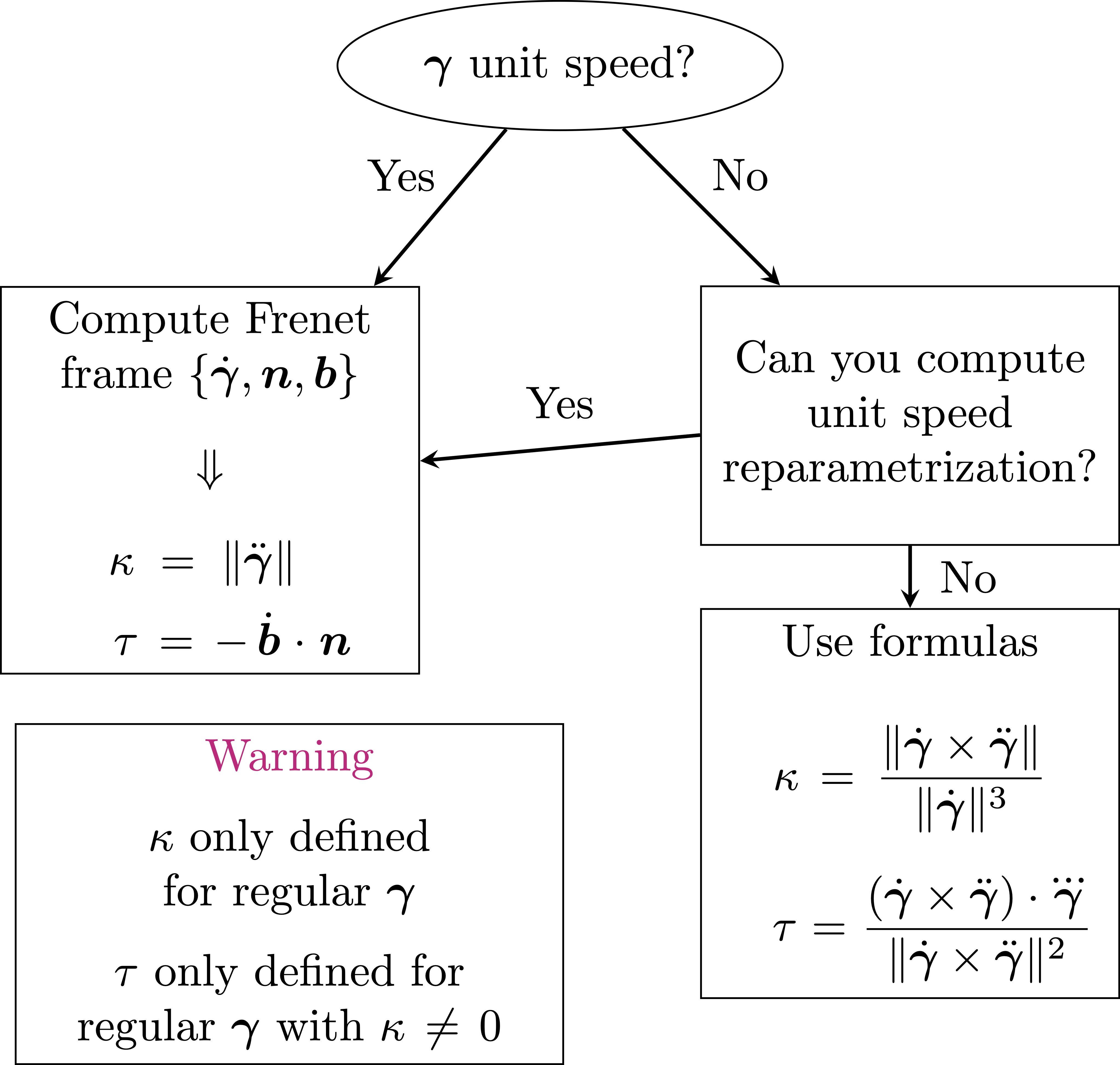
We have already made an example in which we compute curvature and torsion of the Helix using the general formulas \[ \kappa = \frac{\left\| \dot{{\pmb{\gamma}}}\times \ddot{{\pmb{\gamma}}} \right\|}{ \left\| \dot{{\pmb{\gamma}}} \right\|^2 } \,, \qquad \tau = \frac{ (\dot{{\pmb{\gamma}}}\times \ddot{{\pmb{\gamma}}}) \cdot \dddot{{\pmb{\gamma}}}}{ \left\| \dot{{\pmb{\gamma}}}\times \ddot{{\pmb{\gamma}}} \right\|^2 } \,. \] We provide an example where we compute curvature and torsion by making use of the Frenet frame.
Example 51: Curvature and torsion of Helix with Frenet frame
Example 52: Calculation of torsion
Solution. Resuming calculations from Example 25, \[ \begin{aligned} \dddot{{\pmb{\gamma}}}& =\left(\frac{8}{5} \sin (t), 2 \cos (t), \frac{6}{5} \sin (t)\right) \\ ( \dot{{\pmb{\gamma}}}\times \ddot{{\pmb{\gamma}}}) \cdot \dddot{{\pmb{\gamma}}}& = \frac{96}{25} \sin (t)-\frac{96}{25} \sin (t) = 0 \\ \tau(t) & = \frac{ ( \dot{{\pmb{\gamma}}}\times \ddot{{\pmb{\gamma}}}) \cdot \dddot{{\pmb{\gamma}}}}{ \left\| \dot{{\pmb{\gamma}}}\times \ddot{{\pmb{\gamma}}} \right\|^2 } = 0 \end{aligned} \]
Example 53: Twisted cubic
Question. Let \({\pmb{\gamma}}\colon \mathbb{R}\to \mathbb{R}^3\) be the twisted cubic \[ {\pmb{\gamma}}(t) = (t,t^2,t^3 ) \,. \]
- Is \({\pmb{\gamma}}\) regular/unit-speed? Justify your answer.
- Compute the curvature and torsion of \({\pmb{\gamma}}\).
- Compute the Frenet frame of \({\pmb{\gamma}}\).
Solution.
\({\pmb{\gamma}}\) is regular, but not-unit speed, because \[\begin{align*} & \dot {\pmb{\gamma}}(t) = (1 , 2t , 3t^2) \\ & \left\| \dot {\pmb{\gamma}}(t) \right\| = \sqrt{1 + 4t^2 + 9t^4} \geq 1 \qquad \left\| \dot{\pmb{\gamma}}(1) \right\| = \sqrt{14} \neq 1 \end{align*}\]
Compute the following quantities \[\begin{align*} & \ddot{{\pmb{\gamma}}}= (0,2,6t) &\,& \left\| \dot{{\pmb{\gamma}}}\times \ddot{{\pmb{\gamma}}} \right\| = 2 \sqrt{ 1 + 9t^2 + 9t^4 } \\ & \dddot {\pmb{\gamma}}= (0,0,6) &\,& (\dot {\pmb{\gamma}}\times \ddot {\pmb{\gamma}}) \cdot \dddot {\pmb{\gamma}}= 12 \\ & \dot {\pmb{\gamma}}\times \ddot {\pmb{\gamma}}= (6t^2, -6t, 2 ) \end{align*}\] Compute curvature and torsion using the formulas: \[\begin{align*} \kappa(t) & = \frac{ \left\| \dot {\pmb{\gamma}}\times \ddot {\pmb{\gamma}} \right\| }{\left\| \dot {\pmb{\gamma}} \right\|^3} = \frac{ 2 \sqrt{ 1 + 9t^2 + 9t^4 } }{ (1 + 4t^2 + 9t^4)^{3/2} } \\ \tau(t) & = \frac{ (\dot {\pmb{\gamma}}\times \ddot {\pmb{\gamma}}) \cdot \dddot {\pmb{\gamma}}}{ \left\| \dot {\pmb{\gamma}}\times \ddot {\pmb{\gamma}} \right\|^2 } = \frac{3}{1 + 9t^2 + 9t^4} \,. \end{align*}\]
By the Frenet frame formulas and the above calculations, \[\begin{align*} \mathbf{t}& = \frac{\dot{{\pmb{\gamma}}}}{\left\| \dot{{\pmb{\gamma}}} \right\|} = \frac{1}{\sqrt{1 + 4t^2 + 9t^4}} \ (1 , 2t , 3t^2) \\ \mathbf{b}& = \frac{ \dot{{\pmb{\gamma}}}\times \ddot{{\pmb{\gamma}}}}{ \left\| \dot{{\pmb{\gamma}}}\times \ddot{{\pmb{\gamma}}} \right\| } = \frac{1}{\sqrt{ 1 + 9t^2 + 9t^4}} (3t^2, -3t, 1 ) \\ \mathbf{n}& = \mathbf{b}\times \mathbf{t} = \frac{(−9t^3 − 2t,1 − 9t^4,6t^3 + 3t)}{\sqrt{ 1 + 9t^2 + 9t^4} \, \sqrt{1 + 4t^2 + 9t^4}} \end{align*}\]
2.7 Frenet-Serret equations
For unit-speed curves \({\pmb{\gamma}}\colon (a,b) \to \mathbb{R}^3\) with non-vanishing curvature we introduced the Frenet frame \[ \{ \mathbf{t}, \mathbf{n}, \mathbf{b}\} \,. \] We proved that the Frenet frame is a positive orthonormal basis of \(\mathbb{R}^3\). We also used such basis to compute curvature \(\kappa\) and torsion \(\tau\) of \({\pmb{\gamma}}\): \[ \kappa := \| \dot{\mathbf{t}} \| \,, \quad \tau := - \dot{\mathbf{b}} \cdot \mathbf{n}\,. \]
In this section we show that the Frenet frame satisfies a linear system of ODEs known as the Frenet-Serret equations. In order to do this, we first need prove that the Frenet frame \[ ( \mathbf{t}, \mathbf{n}, \mathbf{b}) \] is right-handed. Such property holds in general for any positive basis of \(\mathbb{R}^3\) of the form \[ (\mathbf{u}, \mathbf{v}, \mathbf{w}) \,, \qquad \mathbf{w}:= \mathbf{u}\times \mathbf{v}\,. \]
Proposition 54: Frenet frame is right-handed
Proof
Theorem 55: Frenet-Serret equations
Proof
Remark 56: Vectorial form of Frenet-Serret equations
Note: The matrix \(\mathbf{A}\) is anti-symmetric, that is \[ \mathbf{A}^T = - \mathbf{A} \,. \] This observation will be crucial in proving the Fundamental Theorem of Space Curves, which is stated in the next section.
Alternative Notation: With a little abuse of notation we can also write the Frenet-Serret equations as \[ \dot{{\pmb{\Gamma}}} = A {\pmb{\Gamma}} \] where \(A\) is the \(3 \times 3\) time-dependent matrix \[ A \colon (a,b) \to \mathbb{R}^{3 \times 3} \,, \quad A := \left( \begin{array}{ccc} 0 & \kappa & 0 \\ - \kappa & 0 & \tau \\ 0 & -\tau & 0 \end{array} \right) \,, \] and where we think \({\pmb{\Gamma}}\) as a 3 dimensional vector, with each component being a function \(\mathbf{t}, \mathbf{n}\) and \(\mathbf{b}\).
Note that the block in poisition \((i,j)\) of \(\mathbf{A}\) is obtained by multiplying by \(I\) the entry \((i,j)\) of \(A\).
2.8 Fundamental Theorem of Space Curves
The most important consequence of the Frenet-Serret equations is that they allow to fully characterize space curves in terms of curvature and torsion. This is known as the Fundamental Theorem of Space Curves which can be informally stated as:
If we prescribe two functions \(\kappa(t)>0\) and \(\tau(t)\), there exists a unit-speed curve \({\pmb{\gamma}}(t)\) which has curvature \(\kappa(t)\) and torsion \(\tau(t)\). Moreover \(\gamma\) is the only curve with such curvature and torsion, up to rigid motions.
A rigid motion is a rotation about the origin, followed by a translation. Therefore the Theorem is saying that there exists a unique \({\pmb{\gamma}}\) with curvature \(\kappa\) and torsion \(\tau\), up to rotations and translations.
Let us give the analytic definition of rigid motion.
Definition 57: Rigid motion
In the above definition \(I\) is the identity matrix in \(\mathbb{R}^3\) \[ I = \left( \begin{array}{ccc} 1 & 0 & 0 \\ 0 & 1 & 0 \\ 0 & 0 & 1 \end{array} \right) \] It is also useful to introduce the set of orthogonal matrices \[ \mathrm{O}(3) := \{ A \in \mathbb{R}^{3 \times 3} \ \colon \ A^T A = I \} \] Notice that for \(A \in \mathrm{O}(3)\) we have \[ \det(A) = \pm 1 \] Therefore rotations are orthogonal matrices with deteminant \(1\).
Proof. We have \[ 1 = \det(I) = \det (A^T A) = \det (A) \det (A^T) = \det (A)^2 \] and therefore \(\det(A) = \pm 1\).
The precise statement of the Fundamental Theorem of Space Curves is as follows.
Theorem 58: Fundamental Theorem of Space Curves
Let \(\kappa, \tau \ \colon (a,b) \to \mathbb{R}\) be smooth, with \(\kappa>0\). Then:
There exists a unit-speed curve \({\pmb{\gamma}}\ \colon (a,b) \to \mathbb{R}^3\) with curvature \(\kappa(t)\) and torsion \(\tau(t)\).
Suppose that \(\widetilde{{\pmb{\gamma}}}\ \colon (a,b) \to \mathbb{R}^3\) is a unit-speed curve whose curvature \(\widetilde{\kappa}\) and torsion \(\widetilde{\tau}\) satisfy \[ \widetilde{\kappa}(t) = \kappa(t) \,, \quad \widetilde{\tau}(t) = \tau(t) \,, \quad \forall \, t \in (a,b) \,. \] There exists a rigid motion \(M \colon \mathbb{R}^3 \to \mathbb{R}^3\) such that \[ \widetilde{{\pmb{\gamma}}}(t) = M ({\pmb{\gamma}}(t)) \,, \qquad \forall \, t \in (a,b) \,. \]
In other words, curvature and torsion fully characterize space curves. This result is the 3D counterpart of Theorem 31, which said that signed curvature characterizes 2D curves.
The proof of Theorem 57 is rather lengthy and technical. We delay it to the end of the chapter, see Section (Section 2.11). For now, let us show a simple application of Theorem 57.
Example 59: Application of FTSC
Question. Consider the curve \[ {\pmb{\gamma}}( t ) = \left( \sqrt{3}\, t - \sin ( t ) , \sqrt{3} \sin ( t ) + t , 2 \cos ( t ) \right)\,. \]
Calculate the curvature and torsion of \({\pmb{\gamma}}\).
The helix of radius \(R\) and rise \(H\) is parametrized by \[ {\pmb{\eta}}(t) = (R \cos(t), R\sin(t), Ht) \,. \] Recall that \({\pmb{\eta}}\) has curvature and torsion \[ \kappa^{{\pmb{\eta}}} = \frac{R}{R^2 + H^2} \,, \qquad \tau^{{\pmb{\eta}}} = \frac{H}{R^2 + H^2} \,. \] Prove that there exist a rigid motion \(M \colon \mathbb{R}^3 \to \mathbb{R}^3\) such that \[ {\pmb{\gamma}}(t) = M({\pmb{\eta}}(t)) \,, \quad \forall \, t \in \mathbb{R}\,. \tag{2.29}\]
Solution.
Compute curvature and torsion with the formulas \[ \begin{aligned} & \dot {\pmb{\gamma}}(t) = \left( \sqrt{3} - \cos ( t ), \sqrt{3}\cos ( t ) + 1, -2 \sin ( t ) \right) \\ & \ddot {\pmb{\gamma}}(t) = \left( \sin ( t ),-\sqrt{3}\sin ( t ), -2 \cos ( t ) \right) \\ & \dddot {\pmb{\gamma}}(t) = \left( \cos ( t ),-\sqrt{3}\cos ( t ), 2 \sin ( t ) \right) \\ & \dot {\pmb{\gamma}}(t) \times \ddot {\pmb{\gamma}}(t) = {\small \left( -2 \left( \sqrt{3} + \cos ( t ) \right), 2 \left( \sqrt{3} \cos ( t ) - 1 \right), -4 \sin ( t ) \right) }\\ & \left\| \dot {\pmb{\gamma}}(t) \times \ddot {\pmb{\gamma}}(t) \right\|^2 = 32 \\ & \left\| \dot {\pmb{\gamma}}(t) \right\|^2 = 8 \\ & \left( \dot {\pmb{\gamma}}(t) \times \ddot {\pmb{\gamma}}(t) \right) \cdot \dddot {\pmb{\gamma}}( t ) = -8 \\ & \kappa ( t ) = \frac{ \left\| \dot{\pmb{\gamma}}\times \ddot {\pmb{\gamma}} \right\| }{ \left\| \dot{\pmb{\gamma}} \right\|^3 } = \dfrac{\sqrt{32}}{8^{\frac{3}{2}}} = \dfrac{1}{4} \\ & \tau ( t ) = \frac{ \left(\dot{\pmb{\gamma}}\times \ddot{\pmb{\gamma}}\right) \cdot \dddot {\pmb{\gamma}}}{ \left\| \dot{\pmb{\gamma}}\times \ddot{\pmb{\gamma}} \right\|^2 } = \dfrac{-8}{32} = -\dfrac{1}{4} \, . \end{aligned} \]
Equating \(\kappa = \kappa^{{\pmb{\eta}}}\) and \(\tau = \tau^{{\pmb{\eta}}}\), we obtain \[ \frac{R}{R^2 + H^2} = \frac{1}{4} \,, \qquad \frac{H}{R^2 + H^2} = - \frac{1}{4} \] Rearranging both equalities we get \[ R^2 + H^2 = 4 R \,, \qquad R^2 + H^2 = -4 H \,, \] from which we find the relation \(R = - H\). Substituting into \(R^2 + H^2 = -4 H\), we get \[ H = - 2 \,, \quad R = - H = 2 \,. \] For these values of \(R\) and \(H\) we have \(\kappa = \kappa^{{\pmb{\eta}}}\) and \(\tau = \tau^{{\pmb{\eta}}}\). By the FTSC, there exists a rigid motion \(M \colon \mathbb{R}^3 \to \mathbb{R}^3\) satisfying (2.29).
2.9 Applications of Frenet-Serret
We now state and prove two results which directly follow from the Frenet-Serret equations. They state, respectively:
A curve has torsion \(\tau = 0\) if and only if it is contained in a plane.
A curve has constant curvature \(\kappa > 0\) and torsion \(\tau = 0\) if and only if it is part of a circle.
Before proceeding, we recall the definition plane in \(\mathbb{R}^3\).
Remark 60: Equation of a plane
\[ \pmb{\pi}_d = \{ \mathbf{x}\in \mathbb{R}^3 \, \colon \, \mathbf{x}\cdot \mathbf{P} = d \}\,, \] for some vector \(\mathbf{P} \in \mathbb{R}^3\) and scalar \(d \in \mathbb{R}\). Note that:
If \(d = 0\), the condition \[ \mathbf{x}\cdot \mathbf{P} = 0 \] is saying that the plane \(\pmb{\pi}_0\) contains all the points \(\mathbf{x}\) in \(\mathbb{R}^3\) which are orthogonal to \(\mathbf{P}\). In particular \(\pmb{\pi}_0\) contains the origin \({\pmb{0}}\).
If \(d \neq 0\), then \(\pmb{\pi}_d\) is the translation of \(\pmb{\pi}_0\) by the quantity \(d\) in direction \(\mathbf{P}\).
In both cases, \(\mathbf{P}\) is the normal vector to the plane, as shown in Figure 2.9.
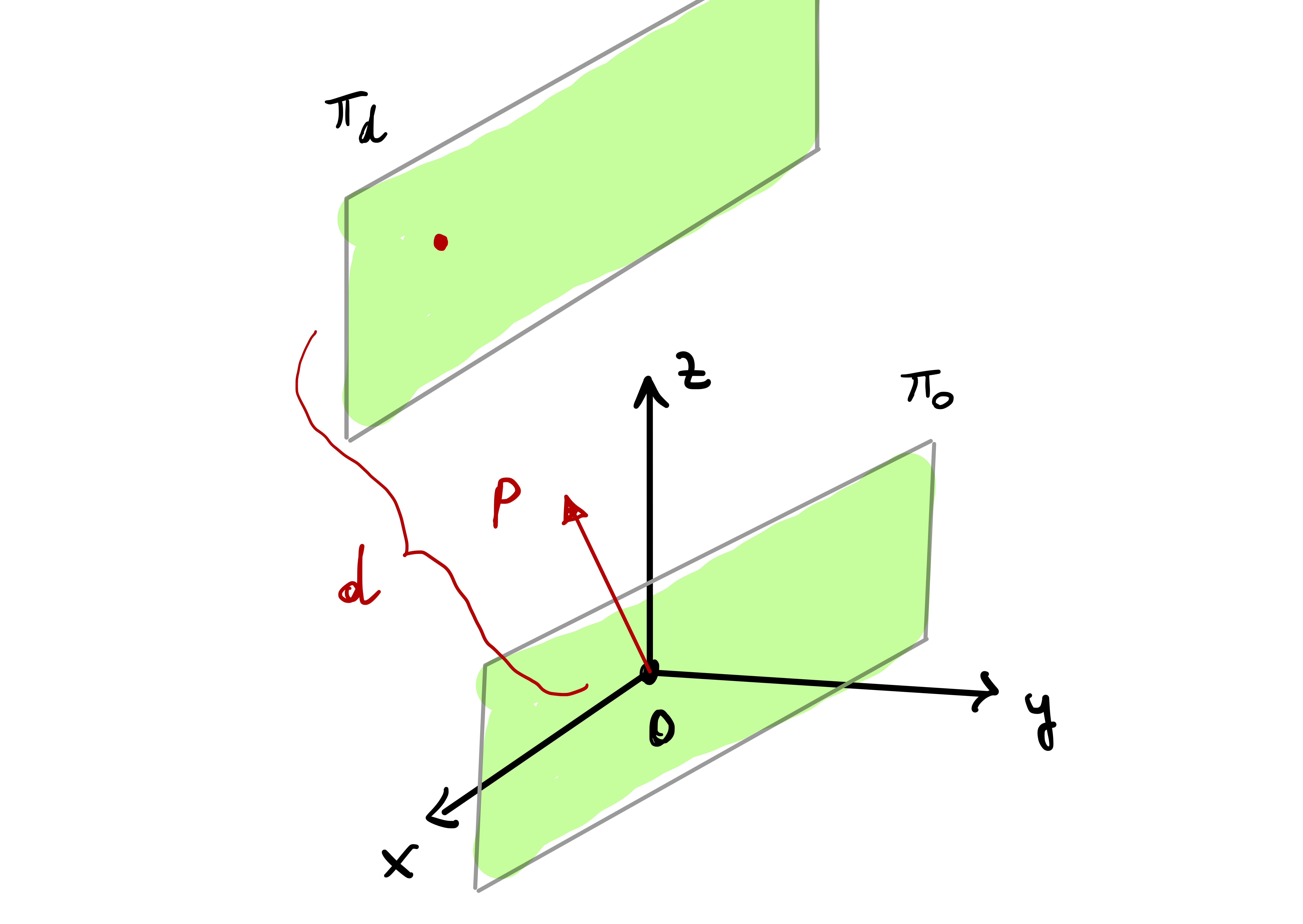
Theorem 61: Curves contained in a plane - Part I
Let \({\pmb{\gamma}}\colon (a,b) \to \mathbb{R}^3\) be regular with \(\kappa \neq 0\). They are equivalent:
The torsion of \({\pmb{\gamma}}\) satisfies \[ \tau(t) = 0 \,, \quad \forall \, t \in (a,b) \,. \]
\({\pmb{\gamma}}\) is contained in a plane: There exists a vector \(\mathbf{P} \in \mathbb{R}^3\) and a scalar \(d \in \mathbb{R}\) such that \[ {\pmb{\gamma}}(t)\cdot \mathbf{P} = d \,, \quad \forall \, t \in (a,b) \,. \]
Idea of the proof: The third Frenet-Serret equation states that \[ \dot{\mathbf{b}} = - \tau \mathbf{n} \] Therefore \(\tau=0\) if and only if \(\dot{\mathbf{b}} = 0\), which means that \(\mathbf{b}\) is constant. Now, \(\mathbf{b}\) is orthogonal to the other two vectors \(\mathbf{t}, \mathbf{n}\) of the Frenet-Frame. Since \(\mathbf{b}\) is constant, this means \(\mathbf{t}, \mathbf{n}\) span a constant plane which has \(\mathbf{b}\) as normal vector. This tells us \({\pmb{\gamma}}\) is contained in the plane \[ {\pmb{\gamma}}\cdot \mathbf{b}= d \] for suitable \(d \in \mathbb{R}\). Let’s prove this!
Proof
Proof. If we were to consider \(\widetilde{{\pmb{\gamma}}}\) a unit-speed reparametrization of \({\pmb{\gamma}}\), then \(\widetilde{{\pmb{\gamma}}}\) would still be contained in the same plane as \({\pmb{\gamma}}\) is contained. Moreover curvature and torsion are invariante under reparametrization, and so \(\widetilde{{\pmb{\gamma}}}\) would still have non-zero curvature and identically zero torsion.
As \({\pmb{\gamma}}\) is unit-speed, it is well defined the Frenet frame \[ \{ \mathbf{t}(t), \mathbf{n}(t) ,\mathbf{b}(t) \} \,. \]
Step 1. Suppose \(\tau = 0\) for all \(t\). By the third Frenet-Serret equation \[ \dot{\mathbf{b}} = -\tau(t) \mathbf{n}= {\pmb{0}}\,, \] so that \(\mathbf{b}(t)\) is constant. As by definition \[ \mathbf{b}= \mathbf{t}\times \mathbf{n}\,, \] we conclude that the vectors \(\mathbf{t}(t)\) and \(\mathbf{n}(t)\) always span the same plane, which has constant normal vector \(\mathbf{b}\). Intuition suggests that \({\pmb{\gamma}}\) should be contained in such plane, see Figure Figure 2.10. Indeed \[ \frac{d}{dt} ( {\pmb{\gamma}}\cdot \mathbf{b}) = \dot{{\pmb{\gamma}}}\cdot \mathbf{b}+ \ddot{{\pmb{\gamma}}}\cdot \dot{\mathbf{b}} = 0\,, \] where we used that \(\dot{\mathbf{b}}=0\) and that the Frenet frame is orthonormal, i.e. \[ \dot{{\pmb{\gamma}}}\cdot \mathbf{b}= \mathbf{t}\cdot \mathbf{b}= 0 \,. \] Thus \({\pmb{\gamma}}\cdot \mathbf{b}\) has zero derivative, meaning it is constant: there exists \(d \in \mathbb{R}\) such that \[ {\pmb{\gamma}}(t) \cdot \mathbf{b}= d \,, \,\, \forall \, t \in (a,b) \,. \tag{2.30}\] This shows that \({\pmb{\gamma}}\) is conatained in a plane orthogonal to \(\mathbf{b}\), and the first part of the proof is concluded.
Step 2. Suppose that \({\pmb{\gamma}}\) is contained in a plane. Hence there exists \(\mathbf{P} \in \mathbb{R}^3\) and \(d \in \mathbb{R}\) such that \[ {\pmb{\gamma}}(t)\cdot \mathbf{P} = d \,, \quad \forall \, t \in (a,b) \,. \] We can differentiate the above equation twice to obtain \[ \dot{{\pmb{\gamma}}}\cdot \mathbf{P} = 0 \,, \quad \ddot{{\pmb{\gamma}}}\cdot \mathbf{P} = 0 \,, \] where we used that \(\mathbf{P}\) and \(d\) are constant. The first equation says that \(\dot{{\pmb{\gamma}}}(t)\) is orthogonal to \(\mathbf{P}\). By the first Frenet-Serret equation we have \[ \ddot{{\pmb{\gamma}}}(t)= \dot{\mathbf{t}} = \kappa (t) \mathbf{n}(t) \,. \] Therefore the already proven relation \(\ddot{{\pmb{\gamma}}}\cdot \mathbf{P} = 0\) implies \[ \kappa (t) \mathbf{n}(t) \cdot \mathbf{P} = 0 \,. \] As we are assuming \(\kappa \neq 0\), we deduce that \[ \mathbf{n}(t) \cdot \mathbf{P} = 0 \,, \quad \forall \, t \in (a,b) \,. \] In conclusion, we have shown that \(\mathbf{P}\) is orthogonal to both \(\dot{{\pmb{\gamma}}}(t)\) and \(\mathbf{n}(t)\). Since \(\mathbf{b}(t)\) is orthogonal to both \(\dot{{\pmb{\gamma}}}(t)\) and \(\mathbf{n}(t)\), we conclude that \(\mathbf{b}(t)\) is parallel to \(\mathbf{P}\). Hence, there exists \(\lambda(t) \in \mathbb{R}\) such that \[ \mathbf{b}(t) = \lambda(t) \mathbf{P} \,, \quad \forall \, t \in (a,b) \,. \] Since \(\left\| \mathbf{b} \right\| = 1\) and \(\mathbf{P}\) is constant, from (2.31) we conclude that \(\lambda(t)\) is constant and non-zero. Thus \[ \mathbf{b}(t) = \hat{\lambda} \mathbf{P} \,, \quad \forall \, t \in (a,b) \,, \tag{2.31}\] for some \(\hat{\lambda} \neq 0\). Differentiating (2.31) we obtain \[ \dot{\mathbf{b}}(t) = 0 \,, \quad \forall \, t \in (a,b) \,, \] meaning that the binormal \(\mathbf{b}\) is a constant vector. By definition of torsion \[ \tau(t) = - \dot{\mathbf{b}} \cdot \mathbf{n}(t) = 0 \,, \quad \forall \, t \in (a,b) \,, \] as required.
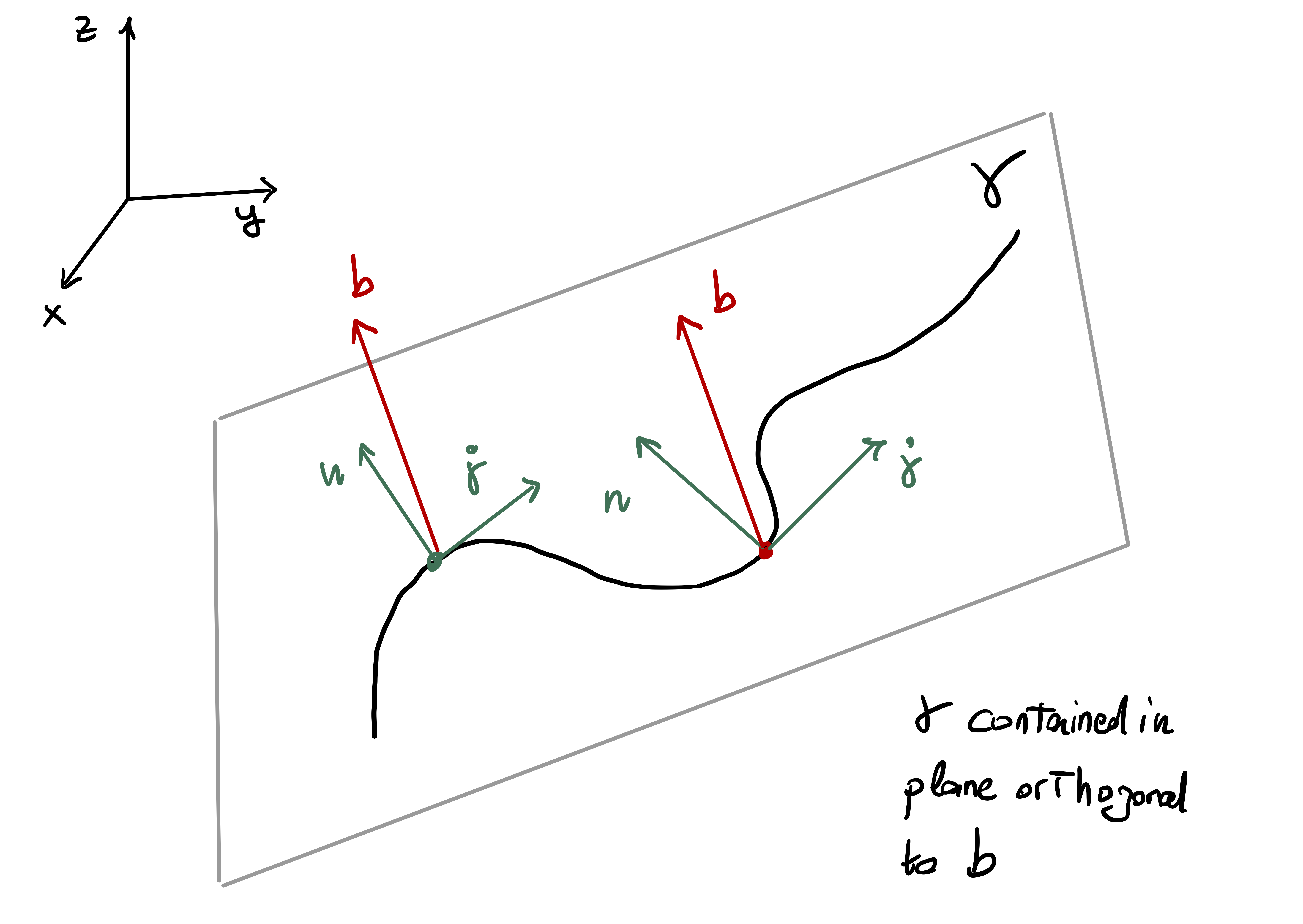
As a corollary of Step 1 in the proof of Theorem 61 we obtain the following statement.
Theorem 62: Curves contained in a plane - Part II
Proof
Example 63: A planar curve
Question. Consider the curve \[ {\pmb{\gamma}}(t) = ( t,2t,t^4) \,, \quad t > 0 \,. \]
Prove that \({\pmb{\gamma}}\) is regular.
Compute the curvature and torsion of \({\pmb{\gamma}}\).
Prove that \({\pmb{\gamma}}\) is contained in a plane. Compute the equation of such plane.
Solution.
\({\pmb{\gamma}}\) is regualar because \(\dot{{\pmb{\gamma}}}(t) = (1,2,4t^3) \neq {\pmb{0}}\).
Compute the following quantities \[\begin{align*} & \left\| \dot{{\pmb{\gamma}}} \right\| = \sqrt{5 + 16 t^4} &\,& \dot{{\pmb{\gamma}}}\times \ddot{{\pmb{\gamma}}}= 12 \,(2t^2, -t^2, 0) \\ & \ddot{{\pmb{\gamma}}}= 12 \, (0,0,t^2) &\,& \left\| \dot{{\pmb{\gamma}}}\times \ddot{{\pmb{\gamma}}} \right\| = 12 \sqrt{5} \, t^2 \\ & \dddot{{\pmb{\gamma}}}= 24 \, (0,0,t) &\,& (\dot{{\pmb{\gamma}}}\times \ddot{{\pmb{\gamma}}}) \cdot \dddot{{\pmb{\gamma}}}= 0 \\ \end{align*}\] Compute curvature and torsion with the formulas \[\begin{align*} & \kappa(t) = \frac{\dot{{\pmb{\gamma}}}\times \ddot{{\pmb{\gamma}}}}{\left\| \dot{{\pmb{\gamma}}} \right\|^3} = \frac{12 \sqrt{5} \, t^2}{\sqrt{ 5 + 16 t^4 }} \\ & \tau(t) = \frac{(\dot{{\pmb{\gamma}}}\times \ddot{{\pmb{\gamma}}}) \cdot \dddot{{\pmb{\gamma}}}}{ \left\| \dot{{\pmb{\gamma}}}\times \ddot{{\pmb{\gamma}}} \right\| } = 0 \,. \end{align*}\]
\({\pmb{\gamma}}\) lies in a plane because \(\tau = 0\). The binormal is \[ \mathbf{b}= \frac{\dot{{\pmb{\gamma}}}\times \ddot{{\pmb{\gamma}}}}{\left\| \dot{{\pmb{\gamma}}}\times \ddot{{\pmb{\gamma}}} \right\|} = \frac{1}{\sqrt{5}} \, (2,-1,0) \,. \] At \(t_0 = 0\) we have \({\pmb{\gamma}}\left( 0 \right) = {\pmb{0}}\). The equation of the plane containing \({\pmb{\gamma}}\) is then \(\mathbf{x}\cdot \mathbf{b}= 0\), which reads \[ \frac{2}{\sqrt5} x - \frac{1}{\sqrt5} y = 0 \quad \implies \quad 2x - y = 0 \,. \]
We now state and prove the second result anticipated at the beginning of this section.
Theorem 64: Curves contained in a circle
Let \({\pmb{\gamma}}\colon (a,b) \to \mathbb{R}^3\) be unit-speed. They are equivalent:
\({\pmb{\gamma}}\) is contained in a circle of radius \(R>0\).
There exists \(R>0\) such that \[ \kappa (t) = \frac{1}{R} \,, \quad \tau(t) = 0\,, \quad \forall \, t \in (a,b)\,. \]
Theorem 64 is actually a consequence of the Fundamental Theorem of Space Curves Theorem 57, and of the fact that we have computed that for a circle of radius \(R\) one has \[ \kappa = \frac1R \,, \quad \tau = 0\,. \] Therefore, by Theorem 57, every unit-speed curve \({\pmb{\gamma}}\) with constant curvature and torsion must be equal to a circle, up to rigid motions.
Nevertheless, we still give a proof of Theorem 64, to show yet another explicit application of the Frenet-Serret equations.
Proof
Step 2. Suppose that \[ \kappa (t) = \frac{1}{R} \,, \quad \tau(t) = 0\,, \quad \forall \, t \in (a,b)\,, \] for some constant \(R > 0\). Since \({\pmb{\gamma}}\) is unit-speed, it is well defined the Frenet frame \[ \{ \mathbf{t}, \mathbf{n},\mathbf{b}\} \,. \] Due to the assumptions on \(\kappa\) and \(\tau\) the Frenet-Serret equations read \[\begin{align*} \dot{\mathbf{t}} & = \kappa \mathbf{n}= \frac{1}{R} \, \mathbf{n}\\ \dot{\mathbf{n}} & = - \kappa \mathbf{t}+ \tau \mathbf{b}= - \frac{1}{R} \mathbf{t}\\ \dot{\mathbf{b}} & = -\tau \mathbf{n}= {\pmb{0}} \end{align*}\] In particular \(\dot{\mathbf{b}}={\pmb{0}}\) and so \(\mathbf{b}\) is a constant vector. As seen in the proof Thoerem 61, this implies that \({\pmb{\gamma}}\) is contained in a plane \({\pmb{\pi}}\) orthogonal to \(\mathbf{b}\), see Figure 2.10. As \(c\) is constant we get \[ \frac{d}{dt} \left( {\pmb{\gamma}}+ R \mathbf{n}\right) = \dot{{\pmb{\gamma}}}+ R \dot{\mathbf{n}} = \mathbf{t}- R \, \frac{1}{R} \mathbf{t}= 0 \,, \] where we used that \(\dot{{\pmb{\gamma}}}= \mathbf{t}\) and the second Frenet-Serret equation. Therefore \[ {\pmb{\gamma}}(t) + R \mathbf{n}(t) = \mathbf{p}\,, \quad t \in (a,b) \,, \] for some constant point \(\mathbf{p}\in \mathbb{R}^3\). In particular \[ \left\| {\pmb{\gamma}}(t) - \mathbf{p} \right\| = \left\| -R \mathbf{n}(t) \right\| = R \,, \] since \(\mathbf{n}\) is a unit vector and \(R>0\). The above shows that \({\pmb{\gamma}}\) is contained in a sphere of radius \(R\) and center \(\mathbf{p}\). In formulas: \[ {\pmb{\gamma}}(t) \in \mathcal{S}:= \{ \mathbf{x}\in \mathbb{R}^3 \, \colon \, \left\| \mathbf{x}- \mathbf{p} \right\| = R \} \,. \] The intersection of \(\mathcal{S}\) with the plane \({\pmb{\pi}}\) is a circle \(\mathcal{C}\) with some radius \(r \geq 0\) (note that \(\mathcal{C}\) might be a single point, in which case \(r = 0\)). As we have shown \[ {\pmb{\gamma}}\in {\pmb{\pi}}\,, \quad {\pmb{\gamma}}\in \mathcal{S}\,, \] we conclude that \[ {\pmb{\gamma}}\in {\pmb{\pi}}\cap \mathcal{S}= \mathcal{C} \,. \tag{2.32}\] Therefore \({\pmb{\gamma}}\) parametrizes part of \(\mathcal{C}\). This immediately implies that \(r > 0\).
Proof. If \(r = 0\) then \(\mathcal{C}\) is a single point, meaning that \({\pmb{\gamma}}\) is constant. But then \(\dot{{\pmb{\gamma}}}= 0\) which contradicts the assumption that \({\pmb{\gamma}}\) is unit speed.
Since \(\mathcal{C}\) is a circle of radius \(r>0\), Step 1 of the proof implies that the curvature and torsion of \({\pmb{\gamma}}\) satisfy \[ \kappa = \frac1r \,, \quad \tau = 0 \,. \] As by assumption \(\kappa=1/R\), we conclude that \(R=r\). Therefore the circle \(\mathcal{C}\) has radius \(R\) and the thesis follows by (2.32).
Example 65
Question. Consider the curve \[ {\pmb{\gamma}}(t) = \left( \frac45 \cos(t), 1 - \sin(t) , -\frac35 \cos(t) \right) \,. \]
- Prove that \({\pmb{\gamma}}\) is unit-speed.
- Compute Frenet frame, curvature and torsion of \({\pmb{\gamma}}\).
- Prove that \({\pmb{\gamma}}\) is part of a circle.
Note: As seen in the plot in Figure 2.11, \({\pmb{\gamma}}\) is just a Circle which has been rotated an translated.
Solution.
\({\pmb{\gamma}}\) is unit-speed because \[\begin{align*} \dot{{\pmb{\gamma}}}(t) & = \left( -\frac45 \sin(t), - \cos(t) , \frac35 \sin(t) \right) \\ \left\| \dot{{\pmb{\gamma}}}(t) \right\|^2 & = \frac{16}{25} \sin^2(t) + \cos^2(t) + \frac{9}{25} \sin^2(t) = 1 \end{align*}\]
As \({\pmb{\gamma}}\) is unit-speed, the tangent vector is \(\mathbf{t}(t) = \dot{{\pmb{\gamma}}}(t)\). The curvature, normal, binormal and torsion are \[\begin{align*} \dot{\mathbf{t}} (t) & = \left( -\frac45 \cos(t), \sin(t) , \frac35 \cos(t) \right) \\ \kappa(t) & = \left\| \dot{\mathbf{t}}(t) \right\| = \frac{16}{25} \cos^2(t) + \sin^2(t) + \frac{9}{25} \cos^2(t) = 1 \\ \mathbf{n}(t)& = \frac{1}{\kappa(t)} \ddot{{\pmb{\gamma}}}(t) = \left( -\frac45 \cos(t), \sin(t) , \frac35 \cos(t) \right) \\ \mathbf{b}(t) & = \dot{{\pmb{\gamma}}}(t) \times \mathbf{n}(t) = \left( -\frac35, 0 ,-\frac45 \right) \\ \dot{\mathbf{b}} & = {\pmb{0}}\\ \tau & = - \dot{\mathbf{b}} \cdot \mathbf{n}= 0 \end{align*}\]
The curvature of \({\pmb{\gamma}}\) is constant and the torsion is zero. Therefore \({\pmb{\gamma}}\) is contained in a circle of radius \[ R = \frac{1}{\kappa} = 1 \,. \]
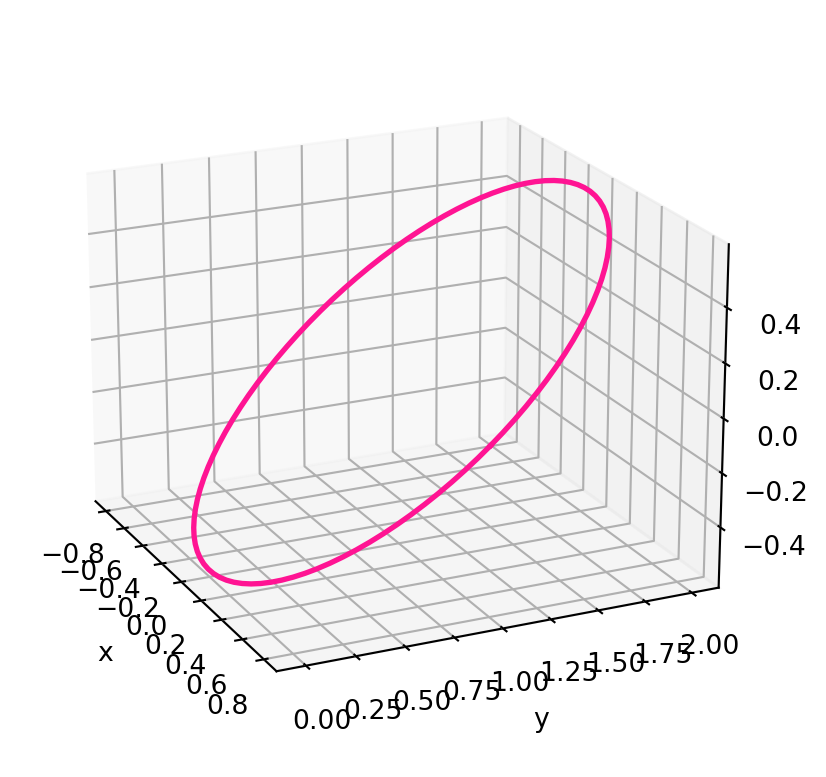
2.10 Proof: Curvature and torsion formulas
Another consequence of the Frenet-Serret equations is that they allow us to finally prove the curvature and torsion formulas given in Theorem 21 and Theorem 48. For reader’s convenience we recall these two results.
Proposition 66: Curvature and torsion formulas
Proof
Part 1. Differentiating \({\pmb{\gamma}}= \widetilde{{\pmb{\gamma}}}\circ s\) we get \[ \dot{{\pmb{\gamma}}}(t) = \dot{\widetilde{{\pmb{\gamma}}}}(s(t)) \ \dot{s}(t) = \widetilde{\mathbf{t}}(s(t)) \ \dot{s}(t) \] Differentiating once more \[ \begin{aligned} \ddot{{\pmb{\gamma}}}(t) & = \frac{d}{dt} \left[ \widetilde{\mathbf{t}}(s(t)) \ \dot{s}(t) \right] \\ & = \dot{\widetilde{\mathbf{t}}} \dot{s}^2 + \widetilde{\mathbf{t}}\, \ddot{s} \\ & = \widetilde{\kappa}\ \widetilde{\mathbf{n}}\ \dot{s}^2 + \widetilde{\mathbf{t}}\, \ddot{s} \end{aligned} \tag{2.35}\] where in the last line we used the first Frenet-Serret equation. We are also omitting the dependence on the point for brevity. We compute \[ \begin{aligned} \dot{{\pmb{\gamma}}}(t) \times \ddot{{\pmb{\gamma}}}(t) & = \widetilde{\mathbf{t}}\ \dot{s} \times \left[ \widetilde{\kappa}\ \widetilde{\mathbf{n}}\ \dot{s}^2 + \widetilde{\mathbf{t}}\ \ddot{s} \right] \\ & = \dot{s}^3 \ \widetilde{\kappa}\ \widetilde{\mathbf{t}}\times \widetilde{\mathbf{n}}+ \dot{s} \ \ddot{s} \ \widetilde{\mathbf{t}}\times \widetilde{\mathbf{t}}\\ & = \dot{s}^3 \ \widetilde{\kappa}\ \widetilde{\mathbf{b}} \end{aligned} \tag{2.36}\] where we used that \(\widetilde{\mathbf{b}}= \widetilde{\mathbf{t}}\times \widetilde{\mathbf{n}}\) by definition, and that \(\widetilde{\mathbf{t}}\times \widetilde{\mathbf{t}}= 0\) by the properties of the cross product. Taking the norms in (2.36) gives \[ \left\| \dot{{\pmb{\gamma}}}(t) \times \ddot{{\pmb{\gamma}}}(t) \right\| = \left\| {\pmb{\gamma}}(t) \right\|^3 \ \widetilde{\kappa}(s(t)) \] where we used that \(\left\| \widetilde{\mathbf{b}} \right\| = 1\) and \(\dot{s} (t) = \left\| {\pmb{\gamma}}(t) \right\|\). Rearranging we get \[ \widetilde{\kappa}(s(t)) = \frac{ \left\| \dot{{\pmb{\gamma}}}(t) \times \ddot{{\pmb{\gamma}}}(t) \right\| }{ \left\| {\pmb{\gamma}}(t) \right\|^3 } \] Recalling that the curvature \(\kappa\) of \({\pmb{\gamma}}\) at \(t\) is defined as \[ \kappa(t) = \widetilde{\kappa}( s(t) ) \] we conclude (2.33).
Part 2. Differentiating the second line in (2.35) we get \[ \begin{aligned} \dddot{{\pmb{\gamma}}}(t) & = \frac{d}{dt} \left[ \dot{\widetilde{\mathbf{t}}}(s(t)) \dot{s}^2(t) + \widetilde{\mathbf{t}}(s(t)) \, \ddot{s}(t) \right] \\ & = \ddot{\widetilde{\mathbf{t}}} \dot{s}^3 + 2\dot{\widetilde{\mathbf{t}}} \dot{s} \ddot{s} + \dot{\widetilde{\mathbf{t}}} \dot{s} \ddot{s} + \widetilde{\mathbf{t}}\ \dddot{s} \\ & = \ddot{\widetilde{\mathbf{t}}} \dot{s}^3 + 3\dot{\widetilde{\mathbf{t}}} \dot{s} \ddot{s} + \widetilde{\mathbf{t}}\ \dddot{s} \end{aligned} \] Therefore, using (2.36), we get \[ \begin{aligned} \left( \dot{{\pmb{\gamma}}}\times \ddot{{\pmb{\gamma}}}\right) \cdot \dddot{{\pmb{\gamma}}} & = \left[\dot{s}^3 \widetilde{\kappa}\ \widetilde{\mathbf{b}}\right] \cdot \left [ \ddot{\widetilde{\mathbf{t}}} \dot{s}^3 + 3\dot{\widetilde{\mathbf{t}}} \dot{s} \ddot{s} + \widetilde{\mathbf{t}}\ \dddot{s} \right] \\ & = \dot{s}^6 \ \widetilde{\kappa}\ \widetilde{\mathbf{b}}\cdot \ddot{\widetilde{\mathbf{t}}} + 3\dot{s}^4 \ \ddot{s} \ \widetilde{\kappa}\ \widetilde{\mathbf{b}}\cdot \dot{\widetilde{\mathbf{t}}} + \dot{s}^3 \ \dddot{s} \ \widetilde{\kappa}\ \widetilde{\mathbf{b}}\cdot \widetilde{\mathbf{t}}\\ & = \dot{s}^6 \ \widetilde{\kappa}\ \widetilde{\mathbf{b}}\cdot \ddot{\widetilde{\mathbf{t}}} \end{aligned} \tag{2.37}\] where the second term is zero by the first Frenet-Serret equation \[ \widetilde{\mathbf{b}}\cdot \dot{\widetilde{\mathbf{t}}} = \widetilde{\kappa}\ \widetilde{\mathbf{b}}\cdot \widetilde{\mathbf{n}}= 0 \,, \] as \(\widetilde{\mathbf{b}}\cdot \widetilde{\mathbf{n}}= 0\), and the thrid term is zero because \(\widetilde{\mathbf{b}}\cdot \widetilde{\mathbf{t}}= 0\). To compute \(\ddot{\widetilde{\mathbf{t}}}\) we differentiate the first Frenet-Serret formula \[ \begin{aligned} \ddot{\widetilde{\mathbf{t}}} & = \frac{d}{ds} \left[ \dot{\widetilde{\mathbf{t}}} \right] \\ & = \frac{d}{ds} \left[ \widetilde{\kappa}\ \widetilde{\mathbf{n}}\right] \\ & = \dot{\widetilde{\kappa}} \ \widetilde{\mathbf{n}}+ \widetilde{\kappa}\ \dot{\widetilde{\mathbf{n}}} \end{aligned} \] Substituting in (2.37) we get \[ \begin{aligned} \left( \dot{{\pmb{\gamma}}}\times \ddot{{\pmb{\gamma}}}\right) \cdot \dddot{{\pmb{\gamma}}} & = \dot{s}^6 \ \widetilde{\kappa}\ \widetilde{\mathbf{b}}\cdot \ddot{\widetilde{\mathbf{t}}} \\ & = \dot{s}^6 \ \widetilde{\kappa}\ \widetilde{\mathbf{b}}\cdot \left[ \dot{\widetilde{\kappa}} \ \widetilde{\mathbf{n}}+ \widetilde{\kappa}\ \dot{\widetilde{\mathbf{n}}} \right] \\ & = \dot{s}^6 \ \widetilde{\kappa}\ \dot{\widetilde{\kappa}} \ \widetilde{\mathbf{b}}\cdot \widetilde{\mathbf{n}}+ \dot{s}^6 \ \widetilde{\kappa}^2 \ \widetilde{\mathbf{b}}\cdot \dot{\widetilde{\mathbf{n}}} \\ & = \dot{s}^6 \ \widetilde{\kappa}^2 \ \widetilde{\mathbf{b}}\cdot \dot{\widetilde{\mathbf{n}}} \end{aligned} \] where we used that \(\widetilde{\mathbf{b}}\cdot \widetilde{\mathbf{n}}= 0\). Using the second Frenet-Serret equation we get \[ \begin{aligned} \left( \dot{{\pmb{\gamma}}}\times \ddot{{\pmb{\gamma}}}\right) \cdot \dddot{{\pmb{\gamma}}} & = \dot{s}^6 \ \widetilde{\kappa}^2 \ \widetilde{\mathbf{b}}\cdot \dot{\widetilde{\mathbf{n}}} \\ & = \dot{s}^6 \ \widetilde{\kappa}^2 \ \widetilde{\mathbf{b}}\cdot \left[ -\widetilde{\kappa}\ \widetilde{\mathbf{t}}+ \widetilde{\tau}\ \widetilde{\mathbf{b}}\right] \\ & = - \dot{s}^6 \ \widetilde{\kappa}^3 \ \widetilde{\mathbf{b}}\cdot \widetilde{\mathbf{t}}+ \dot{s}^6 \ \widetilde{\kappa}^2 \ \widetilde{\tau}\ \widetilde{\mathbf{b}}\cdot \widetilde{\mathbf{b}}\\ & = \dot{s}^6 \ \widetilde{\kappa}^2 \ \widetilde{\tau} \end{aligned} \] where we used that \(\widetilde{\mathbf{b}}\cdot \widetilde{\mathbf{t}}= 0\) and \(\widetilde{\mathbf{b}}\cdot \widetilde{\mathbf{b}}= 1\). Recalling that \(\dot s = \left\| \dot{{\pmb{\gamma}}} \right\|\), and using the already proven formula (2.33), we get \[ \begin{aligned} \left( \dot{{\pmb{\gamma}}}\times \ddot{{\pmb{\gamma}}}\right) \cdot \dddot{{\pmb{\gamma}}} & = \dot{s}^6 \ \widetilde{\kappa}^2 \ \widetilde{\tau}\\ & = \left\| \widetilde{{\pmb{\gamma}}} \right\|^6 \ \frac{ \left\| \dot{{\pmb{\gamma}}}\times \ddot{{\pmb{\gamma}}} \right\|^2 }{ \left\| \dot{{\pmb{\gamma}}} \right\|^6 } \ \widetilde{\tau}\\ & = \left\| \dot{{\pmb{\gamma}}}\times \ddot{{\pmb{\gamma}}} \right\|^2 \ \widetilde{\tau} \end{aligned} \] Rerranging we get \[ \widetilde{\tau}(s(t)) = \frac{ \left( \dot{{\pmb{\gamma}}}(t) \times \ddot{{\pmb{\gamma}}}(t) \right) \cdot \dddot{{\pmb{\gamma}}}(t) }{ \left\| \dot{{\pmb{\gamma}}}(t) \times \ddot{{\pmb{\gamma}}}(t) \right\|^2 } \] Recalling that the torsion \(\tau\) of \({\pmb{\gamma}}\) at \(t\) is defined as \[ \tau(t) = \widetilde{\tau}( s(t) ) \] we conclude (2.34).
2.11 Proof: Fundamental Theorem of Space Curves
In this section we prove the Fundamental Theorem of Space Curves Theorem 57. For reader’s convenience we recall the statement.
Theorem 67: Fundamental Theorem of Space Curves
Let \(\kappa, \tau \ \colon (a,b) \to \mathbb{R}\) be smooth functions, with \(\kappa>0\). Then:
There exists a unit-speed curve \({\pmb{\gamma}}\ \colon (a,b) \to \mathbb{R}^3\) with curvature \(\kappa(t)\) and torsion \(\tau(t)\).
Suppose that \(\widetilde{{\pmb{\gamma}}}\ \colon (a,b) \to \mathbb{R}^3\) is a unit-speed curve whose curvature \(\widetilde{\kappa}\) and torsion \(\widetilde{\tau}\) satisfy \[ \widetilde{\kappa}(t) = \kappa(t) \,, \quad \widetilde{\tau}(t) = \tau(t) \,, \quad \forall \, t \in (a,b) \,. \] Then there exists a rigid motion \(M \colon \mathbb{R}^3 \to \mathbb{R}^3\) such that \[ \widetilde{{\pmb{\gamma}}}(t) = M ({\pmb{\gamma}}(t)) \,, \qquad \forall \, t \in (a,b) \,. \]
The proof relies on the following classical existence Theorem for linear systems of ODEs. For a proof see Page 162 in (Walter 1998).
Theorem 68: Existence and uniqueness for linear ODE systems
We will also need the following 4 Propositions. The first Proposition states that orthogonal matrices preserve scalar product and length.
Proposition 69: Orthogonal matrices preserve scalar product and length
Proof
We now inverstigate how the cross product behaves under linear transformations, i.e., how the cross product of two vector changes under matrix multiplication.
Proposition 70: Linear transformations of cross product
Proof
Part 2. For \(R \in \mathrm{SO}(3)\) it holds \(\det (R) = 1\). Moreover \(R^T R = I\), so that \[ R^{-1}= R^T \quad \implies \quad \left(R^{-1}\right)^{T} = R \] Therefore (2.41) follows from (2.40).
We need to clarify how unit-speed curves and Frenet frame behave under rigid motions.
Proposition 71: Frenet Frame under rigid motions
Proof
Let us now prove (2.42). The relation \(\dot{\widetilde{{\pmb{\gamma}}}}= R \ \dot{{\pmb{\gamma}}}\) reads \[ \widetilde{\mathbf{t}}= R \, \mathbf{t}\,, \] which gives the first equation in (2.42). Since \(\ddot{\widetilde{{\pmb{\gamma}}}}= R \ \ddot{{\pmb{\gamma}}}\), by (2.39) we deduce \[ \left\| \ddot{\widetilde{{\pmb{\gamma}}}} \right\| = \left\| R \ \ddot{{\pmb{\gamma}}} \right\| = \left\| \ddot{{\pmb{\gamma}}} \right\| \] Therefore, by definition of principal normal, \[ \widetilde{\mathbf{n}}= \frac{ \ddot{\widetilde{{\pmb{\gamma}}}}}{ \left\| \ddot{\widetilde{{\pmb{\gamma}}}} \right\| } = \frac{R \ \ddot{{\pmb{\gamma}}}}{\left\| \ddot{{\pmb{\gamma}}} \right\|} = R \, \mathbf{n}\,, \] obtaining the second equation in (2.42). Finally, by definition of binormal and the first two equations in (2.42), \[ \widetilde{\mathbf{b}}= \widetilde{\mathbf{t}}\times \widetilde{\mathbf{n}} = R \ \mathbf{t}\times R \ \mathbf{n} = R \, (\mathbf{t}\times \mathbf{n}) = R \, \mathbf{b} \] where in the third equality we used (2.41). The proof is concluded.
The last Proposition concerns the evolution of orthonormal systems of vectors.
Proposition 72: Evolution of orthonormal systems of vectors
Proof
In order to do so, first note that the ODE in (2.43) reads \[ \dot{\mathbf{u}}_i = \sum_{k=1}^3 a_{ik} \mathbf{u}_k \,, \qquad i = 1,2,3 \tag{2.45}\] Differentiating \(\lambda_{ij}\) yields \[\begin{align*} \dot{\lambda}_{ij} & = \frac{d}{dt} \mathbf{u}_i \cdot \mathbf{u}_j \\ & = \dot{\mathbf{u}}_i \cdot \mathbf{u}_j + \mathbf{u}_i \cdot \dot{\mathbf{u}}_j \\ & = \sum_{k=1}^3 a_{ik} \mathbf{u}_k \cdot \mathbf{u}_j + \sum_{k=1}^3 a_{jk} \mathbf{u}_i \cdot \mathbf{u}_k \\ & = \sum_{k=1}^3 a_{ik} \lambda_{kj} + \sum_{k=1}^3 a_{jk} \lambda_{ik} \end{align*}\] where in the last two equalities we used (2.45) and the definition of \(\lambda_{ij}\). The above calculation shows that \(\lambda_{ij}\) solves the ODE \[ \dot{\lambda}_{ij} = \sum_{k=1}^3 a_{ik} \lambda_{kj} + \sum_{k=1}^3 a_{jk} \lambda_{ik} \tag{2.46}\] We claim that \(\delta_{ij}\) solves (2.46). Indeed the LHS is \(\dot{\delta}_{ij} = 0\), while the RHS is \[ \sum_{k=1}^3 a_{ik} \delta_{kj} + \sum_{k=1}^3 a_{jk} \delta_{ik} = a_{ij} + a_{ji} = 0 \] where we used that \(a_{ij} = - a_{ij}\) because \(A^T = -A\) by assumption. Thus \(\delta_{ij}\) solves (2.46). Moreover we notice that at \(t = t_0\) \[ \lambda_{ij}(t_0) = \mathbf{u}_i (t_0) \cdot \mathbf{u}_j(t_0) = \delta_{ij} \] because the vectors \(\mathbf{u}_1(t_0),\mathbf{u}_2(t_0),\mathbf{u}_3(t_0)\) are orthonormal by assumption. Since \(\lambda_{ij}\) is also a solution to (2.46), by the uniqueness of solutions to ODE systems in Theorem 69, we conclude that (2.44) holds for all \(t\). The proof is concluded.
We are finally ready to prove the Fundamental Theorem of Space Curves.
Proof: Proof of Theorem 66
Part 1. Existence of \({\pmb{\gamma}}\).
Consider the Frenet-Serret system of ODEs \[ \left( \begin{array}{c} \dot{\mathbf{t}} \\ \dot{\mathbf{n}} \\ \dot{\mathbf{b}} \end{array} \right) = A \ \left( \begin{array}{c} \mathbf{t}\\ \mathbf{n}\\ \mathbf{b} \end{array} \right) \tag{2.47}\] where the matrix \(A\) is \[ A = \left( \begin{array}{ccc} 0 & \kappa & 0 \\ - \kappa & 0 & \tau \\ 0 & -\tau & 0 \end{array} \right) \,. \] This is a linear system of \(9\) equations in \(9\) unknowns (the coordinates of \(\mathbf{t},\mathbf{n},\mathbf{b}\)). Therefore Theorem 69 guarantess the existence of a smooth solution \((\mathbf{t},\mathbf{n},\mathbf{b})\) such that \[ \mathbf{t}(t_0) = \mathbf{e}_1 \,, \quad \mathbf{n}(t_0) = \mathbf{e}_2 \,, \quad \mathbf{b}(t_0) = \mathbf{e}_3 \tag{2.48}\] for some fixed \(t_0 \in (a,b)\), where \(\mathbf{e}_1,\mathbf{e}_2,\mathbf{e}_3\) are the vectors of the standard basis of \(\mathbb{R}^3\). Since the matrix \(A\) is anti-symmetric, and the basis \(\{\mathbf{e}_1,\mathbf{e}_2,\mathbf{e}_3\}\) is orthonormal, by Proposition 73 we deduce that \[ (\mathbf{t},\mathbf{n},\mathbf{b}) \,\, \text{ are orthonormal for all } \, t \in (a,b) \] As both \(\mathbf{b}\) and \(\mathbf{t}\times \mathbf{n}\) are unit vectors orthogonal to \(\mathbf{t}\) and \(\mathbf{n}\), we conclude that \[ \mathbf{b}=\lambda \ \mathbf{t}\times \mathbf{n} \] for some continuous function \(\lambda\) such that \(\lambda(t) = \pm 1\). Substituting \(t=t_0\) and recalling (2.48) gives \[ \mathbf{b}(t_0) =\lambda(t_0) \ \mathbf{t}(t_0) \times \mathbf{n}(t_0) \implies \mathbf{e}_3 = \lambda(t_0) \ \mathbf{e}_1 \times \mathbf{e}_2 \] As \(\mathbf{e}_1 \times \mathbf{e}_2 = \mathbf{e}_3\), we conclude that \(\lambda(t_0)= 1\). By continuity of \(\lambda\) we then have \(\lambda \equiv 1\), so that \[ \mathbf{b}= \mathbf{t}\times \mathbf{n} \tag{2.49}\] Define the curve \({\pmb{\gamma}}\colon (a,b) \to \mathbb{R}^3\) by \[ {\pmb{\gamma}}(t) := \int_{t_0}^t \mathbf{t}(u) du \] We now make a few observations:
By the Fundamental Theorem of Calculus we have \[ \dot{{\pmb{\gamma}}}= \mathbf{t} \] showing that \(\mathbf{t}\) is the tangent vector to \({\pmb{\gamma}}\).
In particular \(\dot{{\pmb{\gamma}}}\) is unit-speed, since \(\left\| \mathbf{t} \right\| = 1\).
Using the first equation in (2.47) gives \[ \ddot{{\pmb{\gamma}}}= \dot{\mathbf{t}} = \kappa \ \mathbf{n} \] which shows that \(\kappa\) is the curvature of \({\pmb{\gamma}}\), and \(\mathbf{n}\) the principal normal.
By (2.49) we deduce that \(\mathbf{b}\) is the binormal to \({\pmb{\gamma}}\)
Using the third equation in (2.47) gives \[ \dot{\mathbf{b}} = - \tau \ \mathbf{n} \] showing that \(\tau\) is the torsion of \({\pmb{\gamma}}\)
We have therefore constructed a unit-speed curve \({\pmb{\gamma}}\) with curvature \(\kappa\) and torsion \(\tau\).
Part 2. Uniqueness up to rigid motions.
Suppose that \(\widetilde{{\pmb{\gamma}}}\colon (a,b) \to \mathbb{R}^3\) is a unit-speed curve with curvature \(\widetilde{\kappa}= \kappa\) and torsion \(\widetilde{\tau}= \tau\). Denote by \[ (\mathbf{t},\mathbf{n}, \mathbf{b}) \,, \qquad (\widetilde{\mathbf{t}},\widetilde{\mathbf{n}},\widetilde{\mathbf{b}}) \] the Frenet frames of \({\pmb{\gamma}}\) and \(\widetilde{{\pmb{\gamma}}}\) respectively. Since the above vectors are orthonormal for each \(t\), there exists a rotation \(R \in \mathrm{SO}(3)\) such that \[ \widetilde{\mathbf{t}}(t_0) = R \ \mathbf{t}(t_0) \,, \quad \widetilde{\mathbf{n}}(t_0) = R \ \mathbf{n}(t_0)\,, \quad \widetilde{\mathbf{b}}(t_0) = R \ \mathbf{b}(t_0) \tag{2.50}\] Notice that \(R\) can always be found (for fixed time!) since the vectors are orthonormal. Define \[ \mathbf{p}:= \widetilde{{\pmb{\gamma}}}(t_0) - R \ {\pmb{\gamma}}(t_0) \] We now define the rigid motion \[ M(\mathbf{v}) := R \ \mathbf{v}+ \mathbf{p} \] By construction \[ M({\pmb{\gamma}}(t_0)) = \widetilde{{\pmb{\gamma}}}(t_0) \tag{2.51}\] Define the new curve \[ \hat{{\pmb{\gamma}}}(t) := M({\pmb{\gamma}}(t)) \] By Proposition 71 we know that \(\hat{\pmb{\gamma}}\) is unit-speed, given that \({\pmb{\gamma}}\) is unit-speed. Moreover the Frenet frame of \(\hat{\pmb{\gamma}}\) satisfies \[ \hat{\mathbf{t}} = R \ \mathbf{t}\,, \quad \hat{\mathbf{n}} = R \ \mathbf{n}\,, \quad \hat{\mathbf{b}} = R \ \mathbf{b} \tag{2.52}\] From the above relations we deduce that \((\hat{\mathbf{t}},\hat{\mathbf{n}}, \hat{\mathbf{b}})\) solves the Frenet-Serret equations at (2.47). Since \(\widetilde{{\pmb{\gamma}}}\) has curvature \(\kappa\) and torsion \(\tau\), we also know that \((\widetilde{\mathbf{t}},\widetilde{\mathbf{n}},\widetilde{\mathbf{b}})\) solves the Frenet-Serret equations at (2.47). By evaluating (2.52) at \(t_0\), and comparing with (2.50), we also have that \[ \hat{\mathbf{t}}(t_0) = \widetilde{\mathbf{t}}(t_0) \,, \quad \hat{\mathbf{n}}(t_0) = \widetilde{\mathbf{n}}(t_0) \,, \quad \hat{\mathbf{b}}(t_0) = \widetilde{\mathbf{b}}(t_0) \] By applying the uniqueness in Theorem 69 to the ODE system (2.47), we conclude that \[ \hat{\mathbf{t}} = \widetilde{\mathbf{t}}\,, \quad \hat{\mathbf{n}} = \widetilde{\mathbf{n}}\,, \quad \hat{\mathbf{b}} = \widetilde{\mathbf{b}} \] for all times \(t\). In particular, since \(\widetilde{\mathbf{t}}= \dot{\widetilde{{\pmb{\gamma}}}}\) and \(\hat{\mathbf{t}} = \dot{\hat{{\pmb{\gamma}}}}\), we infer \[ \hat{\mathbf{t}} = \widetilde{\mathbf{t}}\quad \implies \quad \dot{\hat{{\pmb{\gamma}}}} = \dot{\widetilde{{\pmb{\gamma}}}} \] and therefore there exists a constant \(c \in \mathbb{R}^3\) such that \[ \hat{{\pmb{\gamma}}}(t) = \widetilde{{\pmb{\gamma}}}(t) + c \,, \quad \forall \, t \in (a,b) \] By (2.51) and definition of \(\hat{{\pmb{\gamma}}}\), it holds \[ \hat{{\pmb{\gamma}}}(t_0) = M({\pmb{\gamma}}(t_0)) = \widetilde{{\pmb{\gamma}}}(t_0) \] from which we deduce that \(c = 0\). We have therefore proven that \[ \widetilde{{\pmb{\gamma}}}= \hat{{\pmb{\gamma}}} \] Recalling the definition of \(\hat{{\pmb{\gamma}}}\) we conclude that \[ \widetilde{{\pmb{\gamma}}}(t) = M({\pmb{\gamma}}(t)) \] proving uniqueness up to rigid motions.